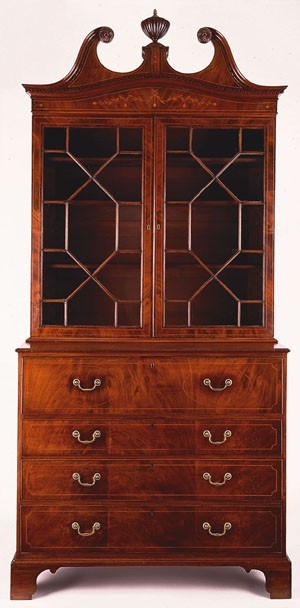
Secretary-and-bookcase, Charleston, 1785–1790. Mahogany and mahogany veneer with white cedar, red cedar, and white pine. H. 105 3/4", W. 48 1/2", D. 24 3/8". (Courtesy, Charleston Museum, Charleston, South Carolina; photo, Gavin Ashworth.) http://charlestonmuseum.org

Detail of the writing compartment of the secretary-and-bookcase illustrated in fig. 1. (Courtesy, Charleston Museum, Charleston, South Carolina; photo, Gavin Ashworth.) http://charlestonmuseum.org
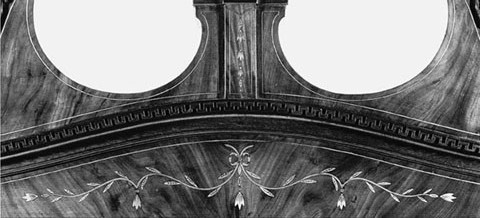
Detail of the pediment of the
secretary-and-bookcase illustrated in fig. 1. (Courtesy, Charleston Museum, Charleston, South Carolina; photo, Gavin Ashworth.) http://charlestonmuseum.org
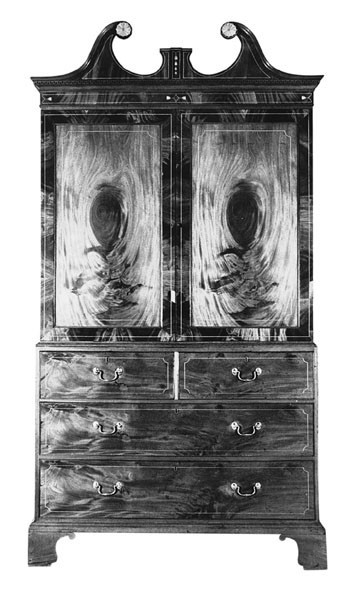


Secretary-and-bookcase on legs, Charleston, 1785–1790. Mahogany and mahogany veneer with cypress and yellow pine. H. 101 3/4", W. 49 13/16", D. 24 7/16". (Courtesy, Baltimore Museum of Art.) The pediment and frieze are constructed on a separate dovetail frame.
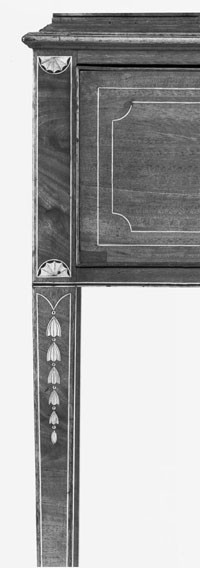
Detail of the leg and drawer inlay on the secretary-and-bookcase on legs illustrated in fig. 6.
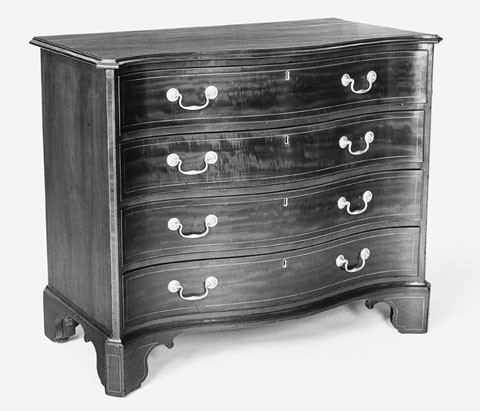
Chest of drawers labeled by William Jones, Charleston, 1788–1789. Mahogany and mahogany veneer with white pine, ash, tulip poplar, and mahogany. H. 34 1/2", W. 42", D. 21 3/4". (Collection of the Museum of Early Southern Decorative Arts.) The drawer-face veneers and stringing are replaced.
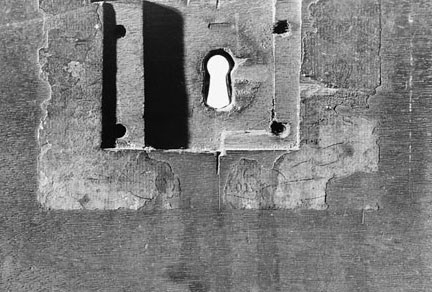
Detail of the label on the chest illustrated in fig. 8.
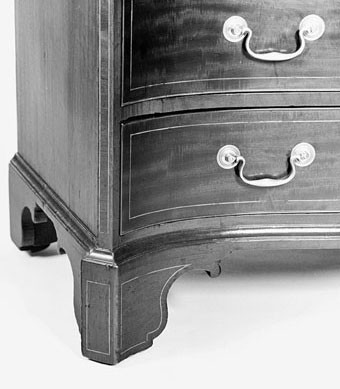
Detail of a canted corner and foot on the chest illustrated in fig. 8.
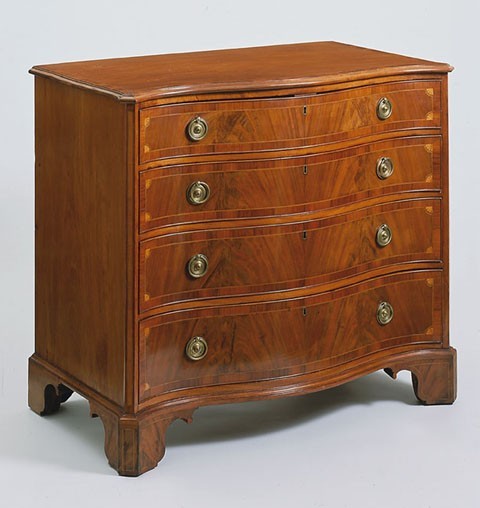
Dressing chest attributed to William Jones, Charleston, 1785–1790. Mahogany and mahogany veneer with white pine, mahogany, and red cedar. H. 37 7/16", W. 40 13/16", D. 23 7/16". (Courtesy, Winterthur Museum; gift of Commander and Mrs. Duncan I. Selfridge.)
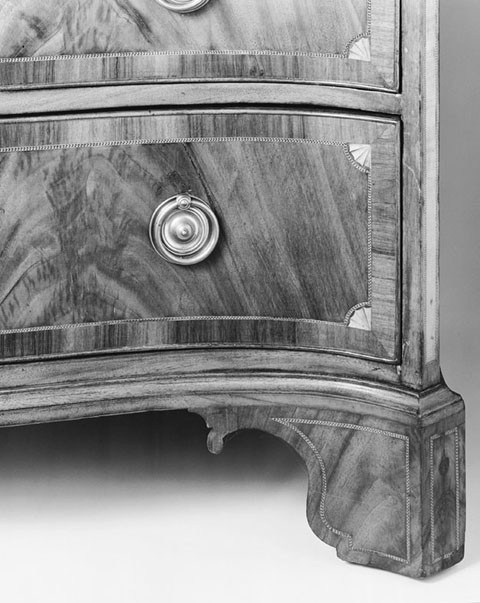
Detail of the veneer and inlay on the drawers, feet, and cants of the dressing chest illustrated in fig. 11.

Detail of the upper drawer of the dressing chest illustrated in fig. 11, with dressing glass deployed.
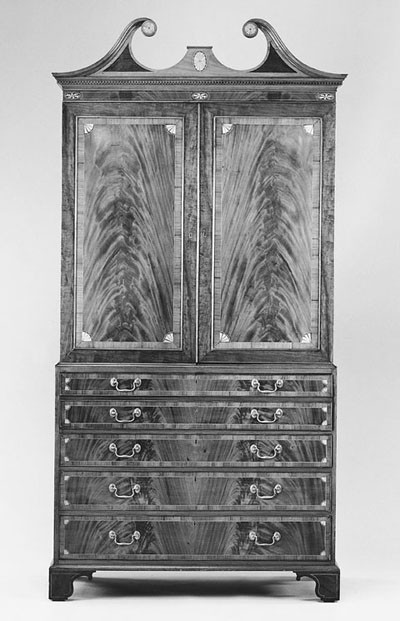
Secretary-press attributed to William Jones, Charleston, 1785–1790. Mahogany and mahogany veneer with white pine, red cedar, and tulip poplar. H. 99 1/4", W. 49 3/8", D. 24 5/8". (Courtesy, Diplomatic Reception Rooms, U.S. Department of State.) Both the upper and lower cases have paneled backs.
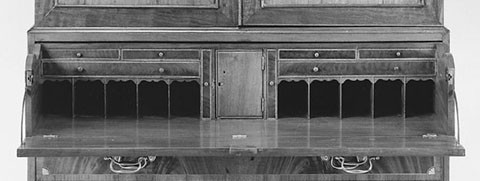
Detail of the writing compartment of the secretary-press illustrated in fig. 14.

Clothespress, Charleston, 1785–1790. Mahogany and mahogany veneer with white pine. H. 91", W. 53 1/4", D. 25 3/4". (Private collection; photo, Dirk Bakker.)
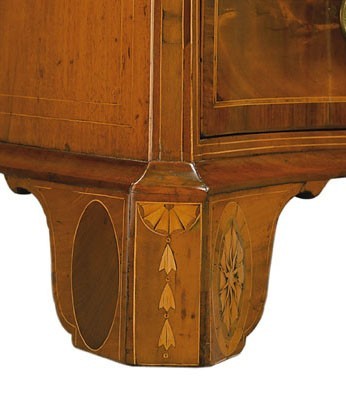
Detail of a foot and canted corner of the clothespress illustrated in fig. 16. (Photo, Museum of Early Southern Decorative Arts.)
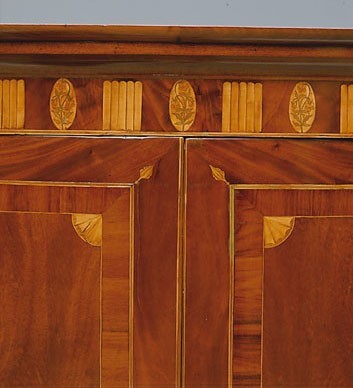
Detail of the frieze of the clothespress illustrated in fig. 16. (Photo, Dirk Bakker.)
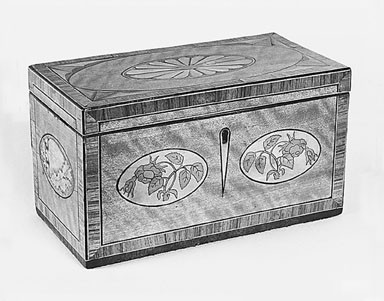
Tea caddy, Britain, 1780–1800. Woods and dimensions unrecorded. (Courtesy, Philip H. Bradley, Inc.; photo, John Bivins.)

Clothespress, Charleston, 1785–1790. Mahogany with white pine. H. 94", W. 51 3/4", D. 24 3/4". (Private collection; photo, Museum of Early Southern Decorative Arts.) The lower right brass has been digitally added to this image.

Detail of the pediment of the clothespress illustrated in fig. 20.
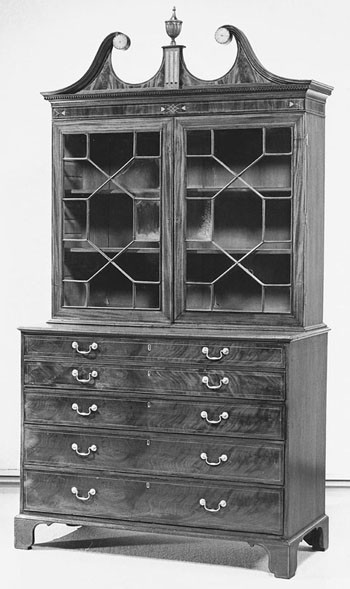
Secretary-and-bookcase, Charleston, 1790–1800. Mahogany and mahogany veneer with red cedar and white pine. H. 104", W. 55 3/8", D. 24 3/8". (Private collection; photo, Museum of Early Southern Decorative Arts.)
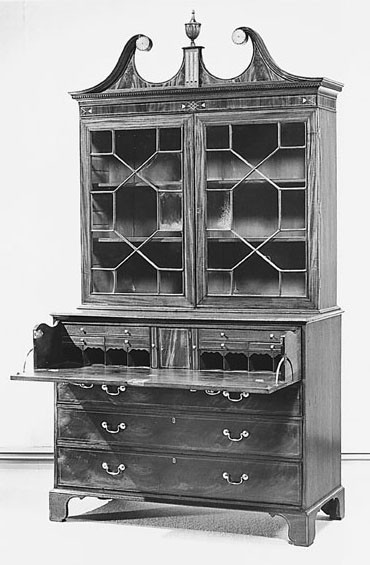
Open view of the secretary-and-bookcase illustrated in fig. 22.

Detail of the pediment of the secretary-and-bookcase illustrated in fig. 22.
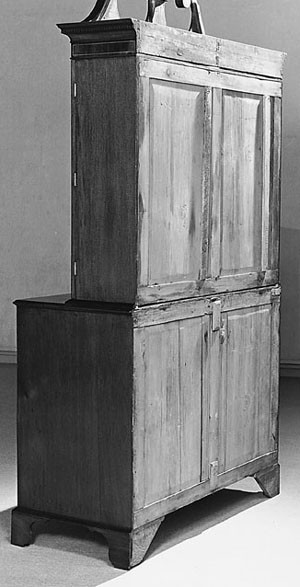
Rear view of the secretary-and-bookcase illustrated in fig. 22, showing the framed pediment and frieze and paneled upper and lower case backs.

Secretary-and-bookcase, Salem, Massachusetts, 1790–1800. Mahogany and mahogany veneer with birch and white pine. H. 96 3/4", W. 43 3/4", D. 24 1/4". (Private collection; photo, Gavin Ashworth.)
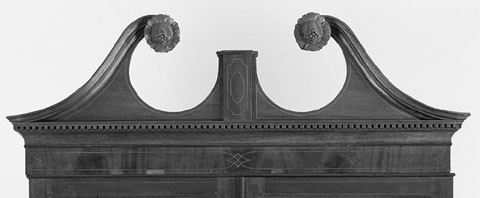
Detail of the pediment of the secretary-and-bookcase illustrated in fig. 26. (Photo, Gavin Ashworth.)
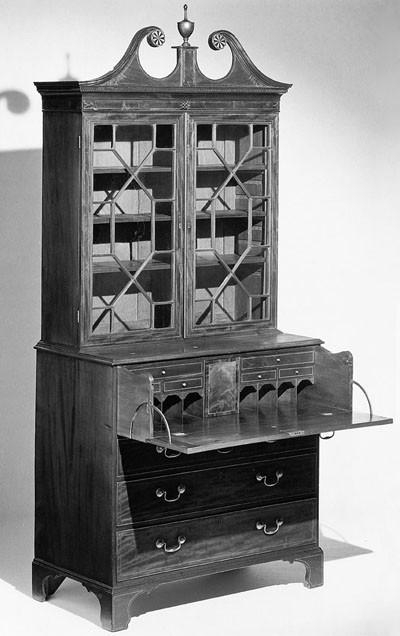
Secretary-and-bookcase labeled by William Appleton, Salem, Massachusetts, 1795–1804 (based upon label address at Charter and Liberty Streets.) Mahogany and mahogany veneer with white pine. H. 97 1/2", W. 43 1/4", D. 24 3/8". (Courtesy, Winterthur Museum.)
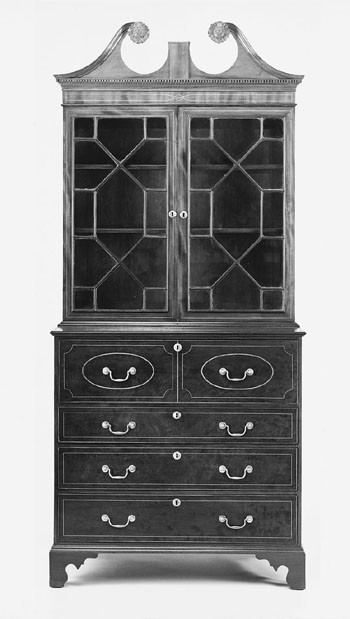
Secretary-and-bookcase labeled by Elijah and Jacob Sanderson, Salem, Massachusetts, 1790–1810. Mahogany and mahogany veneer with red cedar and white pine. H. 97 5/8", W. 43 3/8", D. 24 3/4". (Courtesy, Diplomatic Reception Rooms, U.S. Department of State.)
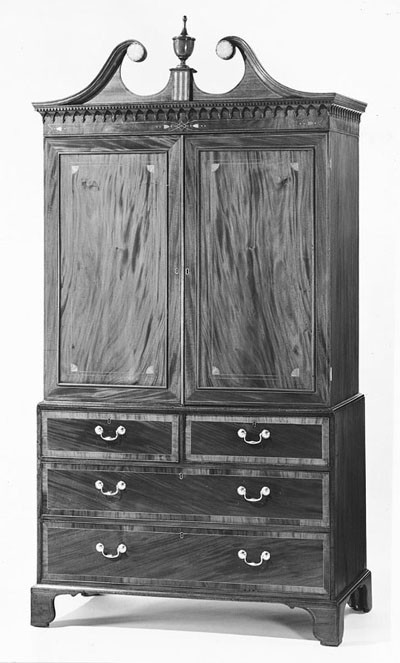
Clothespress, Charleston, 1790–1800. Mahogany and mahogany veneer with yellow pine and white pine. H. 96", W. 50 1/4", D. 24 3/4". (Collection of the Museum of Early Southern Decorative Arts.) The inlaid rosettes and the finial are restorations.
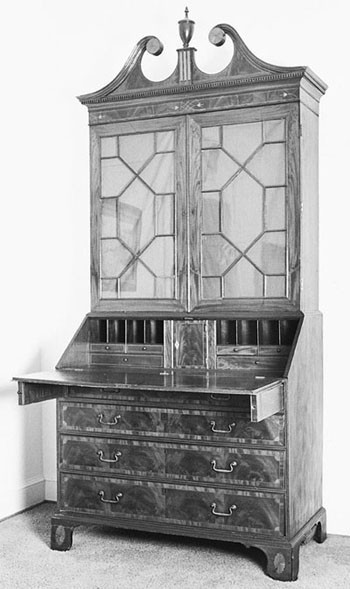
Desk-and-bookcase, Charleston, 1790–1800. Mahogany and mahogany veneer with white pine. H. 983/4" (including finial), W. 45", D. 25". The brasses are replaced. (Private collection; photo, Museum of Early Southern Decorative Arts.)
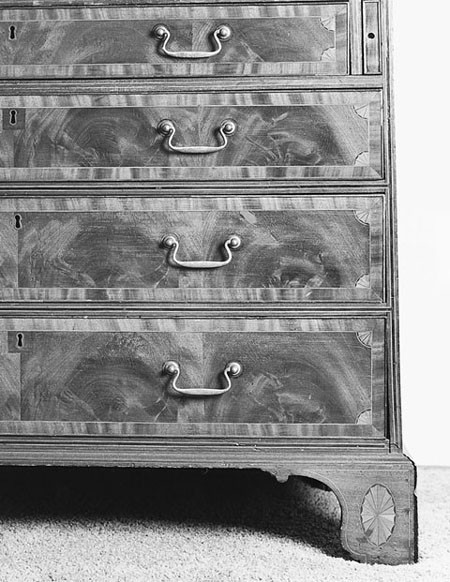
Detail of the lower case of the desk-and-bookcase illustrated in fig. 31.

Chest of drawers, Charleston, 1790–1800. Mahogany and mahogany veneer with red cedar, mahogany, and white pine. H. 37 1/4", W. 41 7/8", D. 22 1/2". (Courtesy, Yale University Art Gallery; gift of C. Stanford Bull.)

Chest of drawers, Salem, Massachusetts, 1790–1800. Mahogany and mahogany veneer with white pine. H. 36 7/16", W. 40 3/8", D. 22 3/8". (Private collection; photo, John Bivins.)

Gentleman’s secretary, Charleston, 1790–1800. Mahogany and mahogany veneer with white pine. H. 115 1/2", W. 76". (Private collection; photo, Museum of Early Southern Decorative Arts.) The door tracery is missing, and the two drawers below the desk drawer are replaced with a cabinet.
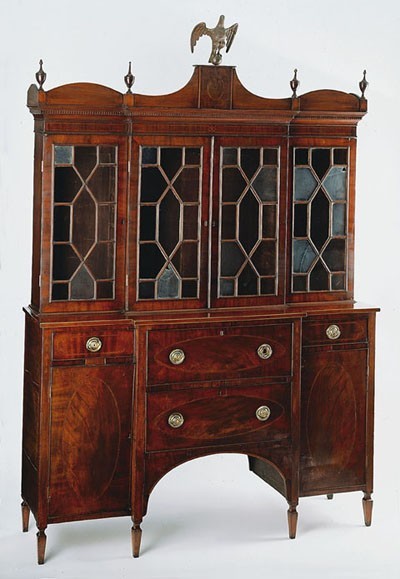
Gentleman’s secretary, Salem, Massachusetts, 1795–1805. Mahogany and mahogany veneer with white pine. H. 99 5/16", W. 67 3/16", D. 18 3/8". (Courtesy, Charleston Museum; photo, Gavin Ashworth.)

Secretary-and-bookcase on legs, Charleston, 1795–1800. Mahogany and mahogany veneer with white pine, tulip poplar, yellow pine, and red cedar. H. 92", W. 42", D. 24". (Courtesy, Sumpter Priddy, III, Inc.; photo, Katherine Wetzel.)
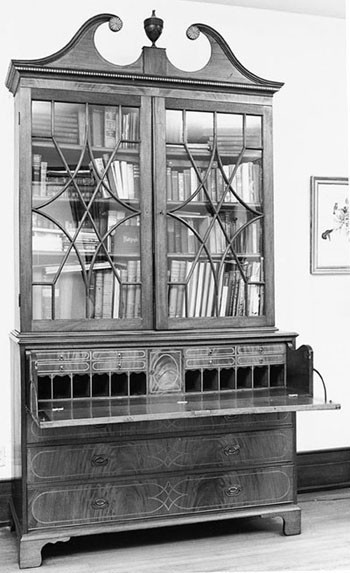
Secretary-and-bookcase signed by Philips & Welch, Charleston, 1800. Mahogany and mahogany veneer with mahogany, yellow pine, and white pine. H. 111 1/2" (including finial), W. 58 1/8", D. 24 1/8". (Private collection; photo, Museum of Early Southern Decorative Arts.)
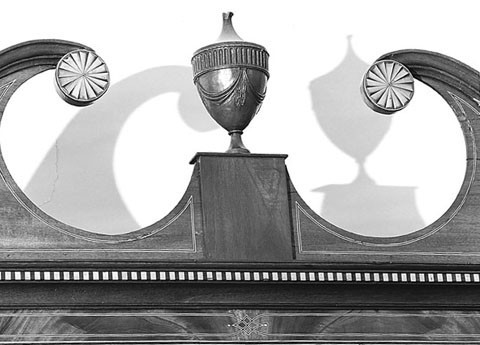
Detail of the pediment of the secretary-and-bookcase illustrated in fig. 38. The top of the finial is missing.
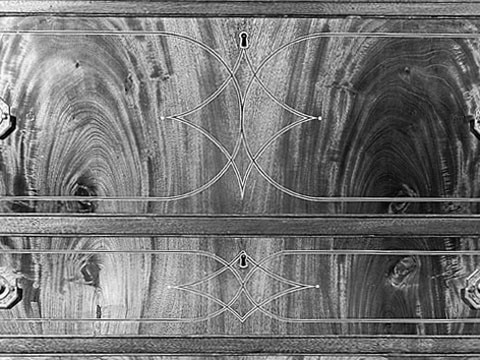
Detail of the lower case of the secretary-and-bookcase illustrated in fig. 38.
As much as any other cultural remnant, furniture from the shops of Charleston cabinetmakers reveals a sophisticated pattern of stylistic development throughout the eighteenth century. This pattern was nourished not only by the cosmopolitan disposition of the city’s inhabitants but also by the complexity of design trends arriving from widespread sources. Charlestonians were ever eager to learn of styles that were both new and modish, as long as they were not excessively flamboyant. From the 1730s to the end of the colonial period, furniture made in the city reflected South Carolina’s position as the diadem in the crown of British mercantilism. Charleston did not export finished goods, but her ships were filled with naval stores, rice, and indigo, all of which brought enormous fortunes to Low Country planters and merchants while handsomely lining the Crown purse. Due to the vast web of business affairs inexorably binding South Carolina planters and merchant houses to British factors, the transmission of British fashion to the city was not only rapid but almost monolithic—at least until the end of the 1760s. After that point, a growing community of Continental artisans began to have a signal effect on Charleston’s furniture. Rapidly following that phenomenon was a host of further design stimuli sailing into Charleston harbor with the American coastal trade, which grew at an astonishing rate during the last decades of the century.
The transition that began in Charleston furniture during the 1770s espoused many ideals characteristic of the neoclassical style already current in London. Despite the well-entrenched British baroque and rococo modes that were so much a part of Charleston furniture before the 1770s, the end of the Revolution coincided in Charleston with a surprisingly abrupt and widespread housecleaning of the “old” styles, perhaps more so than in any other American city. Although the high standards of largely British shop practices did not diminish, they were often applied to new furniture forms. Familiar old forms such as double chests instantly vaporized in cabinet shops seeking to provide movables suitable for fashionable Charleston interiors in the “antique” style. Single houses remained the most common architectural unit, but they were equally transformed. Double and triple piazzas erupted on the long axis of these dwellings, and centrally oriented and more elegant private entrances off the street became the norm. Ceilings continued to rise, and chimneypieces formerly caparisoned with leafage and scrolls “conveyed,” as Thomas Chippendale put it, “from the French Renaissance” were no longer tolerated with anything less ordered than carved paterae, reeding, and composition tableau ushered forth from the ruins of Herculaneum. Political grievances aside, Britain remained the mother of taste, but it was not long before Charlestonians found it equally comfortable to cast an eye upon the fresh efforts of their own countrymen. This phenomenon was a mighty contrast to what had gone on for most of the five decades preceding the flight of the last royal governor out his back door and down Vanderhorst’s Creek to the harbor. More of England left Charleston with William Campbell than just the presence of the Crown.
The interruption of Charleston’s cabinet trade brought about by the Revolution was not especially protracted. Most cabinetmakers working late into the Revolutionary period found themselves short of supplies two years after the war began. Mahogany, fasteners, hardware, glass, varnish components, and glue were imported, and British control of the shipping lanes, as well as loss of British trade links, soon obliterated the availability of such necessities. The capture of the city by Sir Henry Clinton’s troops in May 1780, perhaps one of the signal British victories in the American theater of war, enabled some cabinetmakers—particularly those of loyalist bent—to attain materials as usual. The British sailed out of Charleston’s harbor in mid-December 1782, but although the war was over for South Carolina, time passed before old mercantile links were reestablished. Patterns of trade had been changed forever. Much of the Caribbean was now accessible to American shipping, as were the Continent and the Orient. South Carolina’s place in the American maritime race for new foreign markets, as well as its ability to compete in the rapidly changing commerce between domestic ports, did not resolve itself for some years after the Revolution. Charleston’s dominance among southern ports in its maritime trade eventually diminished somewhat, partially due to the gradual shift from rice and indigo production to cotton and to competition from other ports that had been of little significance during the colonial period.
In Charleston, shifts in both coastal and transatlantic trade naturally affected the bench trades. During the two decades following the war, however, the business of the city continued much as it had, buoyed initially by a postwar boom, only to be palliated for a time by an economic depression that persisted until the late 1780s. By 1790, when Charleston was again flush with fortune, her population had risen to over sixteen thousand, about five thousand more individuals than during the 1770s. In the new era, the nature of Low Country society remained essentially unchanged from the model that had been in place before the end of the seventeenth century. This societal pattern contrasted greatly with that of New England and the middle Atlantic states, and even with the aristocracy of the lower Chesapeake. Fiercely competitive and materialistic Barbadian planters, skilled in both tropical plantation management and political manipulation, had established a social model that suffused the Low Country from the earliest settlement and prevailed well into the nineteenth century. In contrast with Barbados, the Low Country was geographically vast. Whereas a sugar baron in Barbados might have worked no more than two hundred acres of cane, the succeeding generations of their progeny in South Carolina typically owned thousands of acres. Unlike the Chesapeake settlers, Carolina planters were less inclined to develop self-sufficient, isolated domains. They remained steadfastly tied to the business and cultural affairs of Charleston, much to the benefit of the city’s large community of artisans who produced wares “suitable for the country” as well as more elaborate work for the sumptuous residences that scores of planters maintained in town.[1]
Through most of the colonial period, Charleston furniture styles were thoroughly wrapped in thick layers of British fashion. During the golden years following the Seven Years War, and particularly after 1765, the city seemed increasingly open to winds of change from whatever direction fashion wafted. Even before the end of the colonial period some of these stylistic breezes blew from unexpected quadrants, approaching gale force after the mid-1780s. The shift toward the “antique” style had begun in the city during the decade preceding the Revolution. Ironically, the earliest proprietors of the new taste were not staunch members of a British contingent in Charleston’s cabinetmaking trade but were a band of immigrant Germans. By the early 1770s, these men had introduced Franco-German styles, albeit with a strong British twist.
Research by J. Thomas Savage has placed Martin Pfeninger (d. 1782) at the center of this transformation. Following in his stylistic footsteps, and without doubt previously associated with him, were other Germans such as Charles Desel, Henry Gesken, and Jacob Sass, all of whom were working during the 1770s and quickly rose to prominence following the Revolution. Other members of the “German school” who likely were in the city before the end of the Revolution were George Henry Warner and Nicholas Silberg, the latter a Swede. In contrast to earlier Germanic settlers in South Carolina who were primarily from the southwestern states—Baden, Württemberg, and the Rhenish Palatinate—a number of these later emigrés came from the northwestern states—Hesse and the Electorate of Hanover. The latter state developed wide-sweeping stylistic ties with London after the ascent of the “German Georges” to the English throne in 1714. The transmission of British style to north Germany by the House of Hanover at length made its way to Charleston. Henry Gesken was born at Hanover in 1748, and Jacob Sass was born at Schenstad in Hesse in 1750. Charles Desel, from the French spelling of his name, could have been either Alsatian or Swiss, but his Revolutionary War service alongside Sass and Gesken in Charleston’s German Fusiliers as well as his membership in St. John’s Lutheran Church establish his credentials in the city’s German community. All of these men carried Anglo-German style in the cultural baggage they brought to Charleston.[2]
The influence of the north Germans upon Charleston furniture of the late colonial and early neoclassical periods proved to be profound. All senior members of this German school probably arrived in South Carolina during the 1760s as a result of the Bounty Act of 1761, a nefariously administered attempt to lure increasing numbers of Protestant settlers to the Low Country’s hinterland. Between 1761 and 1768, the act led to the emigration of upwards of four thousand settlers, mostly Ulster Scots, Irish, and Germans, all of whom were sent sixty miles or more inland, largely to townships that had been erected in the 1730s. The townships that were either primarily or partially German were Saxe-Gotha, Orangeburg, New Windsor, Amelia, and Londonborough. Artisans such as Pfeninger, Sass, and Gesken, who possessed elevated urban skills, did not remain in these upcountry settlements but quickly joined the small but tightly knit German community in Charleston. Even amidst the complex social stratification of the city, this subculture, in usual Teutonic fashion, maintained a good deal of its cultural identity through and beyond the eighteenth century. The upcountry German townships, not surprisingly, were assimilated even later than the community in Charleston.[3]
While the cabinetmakers of Charleston’s German school flourished, deaths, financial failures, retirements, and, most particularly, unpopular political alliances contributed to the decimation of Charleston’s “old guard” of British-tradition cabinetmakers. John Fisher, Thomas Elfe’s last trade partner, was a loyalist who escaped with the British fleet in 1782, thereby losing his substantial Charleston estate, including an unfinished, three-story brick house on Elliott Street. Thomas Hutchinson, an early partner of Elfe, died in 1782; Elfe had preceded him in 1775. Elfe’s son, Thomas, inherited the business, but he was also a loyalist and quickly sought refuge in Savannah. Abraham Pearce, who had come to Charleston from London in 1763, was a successful carver and cabinetmaker who performed a considerable amount of work for Elfe during the 1770s. Like John Fisher, he returned to England at the end of the war. Richard Magrath, whose lengthy and rambling advertisements identified him as a major importer of British furniture during the 1770s, appears to have returned to London by 1777 after a brief stint at running a ferry across the Combahee River south of Charleston. John Packrow left Charleston for Georgetown in the late 1760s but returned to the city during the Revolution, finally giving up the cabinet trade in 1778 to run the same ferry that Magrath had abandoned. Stephen Townsend retired from the trade in the early 1770s for more genteel pursuits, but his former partner, William Axson, resumed the trade after the war. Axson became one of the most respected artisans in the city, for he led the cabinetmakers in Charleston’s Federal Procession in 1788.
The British cabinetmakers who did manage to struggle through the decade between 1775 and 1785 included established shop masters such as Axson, Mungo Finlayson, John Gough (who was a very enterprising free mulatto), and John Ralph, who had done a good deal of contract work for Elfe. Another of these shop masters was one of Elfe’s former subcontractors, William Luyten, who was a successful cabinetmaker on his own. In 1787 he advertised the sale of his stock-in-trade and appears to have become a merchant. Lesser-known cabinetmakers working during this troubled decade were John Howe, Thomas Snead, George Stewart, James Simmons, Eleazer Philips, and Thomas Cooke, another former Londoner. Philips, like Axson and several other fellow cabinetmakers, was a patriot. He was imprisoned by the British in 1780 but continued in the trade well into the nineteenth century.[4]
About fourteen cabinetmakers working in Charleston between 1775 and 1785 bridged the gap between the colonial period and the Federal era. Of the eight shop masters who headed establishments capable of significant production, three were Germans—Desel, Sass, and Gesken. Shortly thereafter, they were joined by two other cabinetmakers who emerged from the German community, Warner and Silberg. Also associated with one of the German shops was Charles M. S. Nauman, who died in Charleston in 1786 at the age of fifty-two, a seasoned journeyman. The presence of this German minority within the city’s cabinetmaking establishment is evident in the earliest surviving examples of Charleston neoclassical furniture. These foreigners, in fact, formed the first cabinetmaking partnerships in post-war Charleston. Charles Desel and Englishman John Ralph appear to have been associated in 1783. By March 1784, Desel had formed a partnership with Henry Gesken. These men were in business together on Church Street at least until 1789 and possibly as late as 1794. Both were eminently successful as artisans and entrepreneurs. Neither the firm nor its principals ever advertised, probably because they had no need to do so. Gesken died in 1813, and his estate papers have not been found; however, Desel’s 1808 inventory, which totaled almost $15,000, included twenty-six slaves, tools, benches, and unfinished furniture. Jacob Sass was one of the appraisers of the estate.[5]
Two other individuals who probably carried elements of German-school style and construction into the neoclassical period were George Henry Warner and Nicholas Silberg. Unfortunately, we do not know just when either of these men arrived in the city, but it seems likely that both may have been there during the Revolutionary period. Warner was in Charleston by April 1784, when he witnessed a will. Silberg, who was born in Sweden about 1750, does not appear in Charleston records before May 1786, when court records refer to the firm of Warner & Silberg. In February 1787, Silberg announced the termination of that partnership, and Warner disappeared from city records after August of the same year. Silberg formed a partnership with John Ralph in 1793, which lasted for three years. He died in 1801.[6]
Not working with a partner but destined to become the most prominent of the German contingent was Jacob Sass, who was the first cabinetmaker to announce his renewed trade in post-Revolutionary Charleston. A year after the British departed, Sass advertised that he had moved to “a large and commodious shop,” where he carried on the “Cabinet and Upholsterer’s Business . . . where the citizens and others who are unacquainted with the custom of this Country, may be supplied with every necessary for Funerals on the shortest notice.”[7]
Linked with the pre-Revolutionary work of Pfeninger and his colleagues are four neoclassical pieces attributed to two shops: a library bookcase owned by William Alston (1756–1839) (see Thomas Savage’s article in this volume, p. 123, fig. 29), a secretary-and-bookcase with a swelled pediment (fig. 1), a clothespress (fig. 4), and a secretary-and-bookcase on legs (fig. 6). Both secretaries and the press are attributed to the same anonymous shop. Alston, the scion of an enormously wealthy planter family, purchased the Miles Brewton house in 1791, a fitting complement to his numerous plantations. The secretary-and-bookcase illustrated in figure 1 was owned by John Bee Holmes, who inherited John Edwards’s famed library bookcase (see Savage, pp. 106–7, fig. 1).[8]
The attenuated, Louis XV–style base and regional details of inlay and veneer tie the Alston library bookcase to one of the German-school shops whose master was associated with Pfeninger. The base of the Alston bookcase, in fact, is almost exactly the same size as the Edwards example and appears to have been constructed from the same standing patterns or geometric formulas. Whereas the magnificent Edwards piece has no details that are entirely neoclassical, the Alston library bookcase quietly slips into the new style with the form of its inlay (including quarter-fans) and the hardware on its lower drawers. Like the Alston piece, the Holmes secretary-and-bookcase retains a goodly smattering of vocabulary from the Pfeninger period, most particularly the Germanic, swelled pediment (fig. 1). On the secretary, this distinctive baroque feature contrasts with more modish, British details such as the delicate scroll moldings, “Chinese” door tracery, neoclassical writing compartment (fig. 2), and inlaid bracket feet. The leafy, incised inlay on the pediment (fig. 3) seems an attempt, albeit far less refined, to carry on a tradition established by Pfeninger a decade earlier (see Savage, pp. 106-7, fig. 1).[9]
The fine clothespress illustrated in figure 4 (an object often referred to as a “wardrobe” in post-Revolutionary Charleston) has a pediment with elliptical tympanum openings that rise in a tightly decreasing radius to the plinth, similar to those on German-school case pieces from the 1770s. The configuration of the plinth is a close match to that of the Holmes secretary-and-bookcase, and the entire tympanum is outlined in stringing, a typical Charleston feature during and after the 1770s (figs. 3, 5). The husk inlay on the plinth and frieze of the press appears to be the work of the artisan who made the leafy inlays on the Alston library bookcase. The husks (fig. 5) are somewhat fatter than those shown in figure 3, and the incising is different. Regardless of variations between the husks of the Holmes secretary and those on the clothespress and Alston library bookcase, all three pieces document the earliest use of neoclassical-style husks in the Low Country.[10]
Along with the pervasive style of Charleston’s German school, both the press (fig. 4) and secretary-and-bookcase on legs (fig. 6) reveal the earliest influence from the northeast coast of America upon the city’s neoclassical furniture. The composition of the frieze stringing of both pieces, with horizontal husks at each side and another pair reaching out from a central, hollow-sided lozenge of stringing, is a Charleston harbinger of the crossed-string friezes long considered a stylistic hallmark of cabinetmakers working in Salem, Massachusetts, by the 1790s. The same is true of the fanlike rosette inlays, as well as the narrow inlaid pilasters centering the plinths. The rosettes and finial of the Holmes secretary-and-bookcase (fig. 1) are twentieth-century replacements; the original rosettes were probably carved flowers, possibly the pomegranate-like blooms gracing the pediment of the Salem secretary-and-bookcase illustrated in figures 26 and 27. Crossed-string friezes not unlike those shown in figures 4 through 6 occur on British furniture, but they tend to be somewhat less exuberant than their American counterparts.[11]
The foot pattern used on the press and on the Holmes secretary-and-bookcase is essentially the same (figs. 1, 4), although the feet of the former have damaged responds. This style of foot occurred in Britain earlier and was in the Boston-Salem orbit by the 1780s. The Edwards library bookcase (see Savage, pp. 106–7, fig. 1) employs a less vertical version of the same design for its feet. Chippendale illustrated an embryonic version of this pattern in the third edition of The Gentleman and Cabinet-Maker’s Director (1762), and commissions that he executed for Nostell Priory and Harewood House have feet identical to the Charleston/Massachusetts ones. Just how early such details, especially the crossed-string friezes, appear in the Massachusetts Bay area is a matter of conjecture. Most evidence of this style seems to occur on Salem furniture made after 1790, but the Charleston pieces illustrated here were probably made between 1785 and 1790. In any event, the rapid flowering of this style is more than evident in surviving Massachusetts furniture made just after the 1780s. Charleston’s adaptation of these and other Massachusetts details was both immediate and incredibly widespread, springing forth in the work of as many as two dozen shops operating between the late 1780s and 1810. Only a small sampling of this furniture is illustrated here.[12]
With a pediment essentially identical to that of the press (figs. 4, 5) and a sequence of medial moldings that match those on the Holmes secretary-and-bookcase (fig. 1), the secretary-and-bookcase on legs illustrated in figure 6 is a rare form in Charleston furniture. Few other single-drawer secretaries with legs have been recorded in South Carolina, although various renditions of such pieces are seen from New England south to the Cape Fear region of North Carolina. The Charleston example is nearly fifty inches wide, much larger than one might expect for a secretary on legs, usually a far daintier form. The lofty scale of the city’s rooms undoubtedly had a great deal to do with the proportions of Charleston neoclassical furniture; however, the fat girth of some of these pieces also fits baroque proportional ideals, which Teutonic cabinetmakers grimly clung to despite all odds of fashion. The German-school shops responsible for most of the surviving Charleston furniture of the 1780s also may have meddled with their patrons’ perception of fashion, touting the notion that pragmatism of size and relative squareness of mass, both near and dear to the German heart, carried more weight than design-book diatribes on dynamic proportion.
Like the other two pieces from the same shop and typical of the earliest of Charleston neoclassical furniture, the pediment of the secretary-and-bookcase on legs (fig. 6) retains the Doric dentil favored in the city during the colonial period. Also like the Holmes secretary-and-bookcase (figs. 1, 3) and the press illustrated in figures 4 and 5, the secretary-and-bookcase on legs has a removable pediment. In 1771, cabinetmaker Richard Magrath described this structure as “neat and light Pediment Heads, which take off and put on occasionally.”[13]
The long, cross-grained panels of veneer on the legs of this secretary-and-bookcase (fig. 6) are a direct derivation of pre-Revolutionary, German-school work. These panels are complemented by similar ones on the leg stiles that are finished top and bottom with half-fans (fig. 7). The lack of inlaid cuffing below the leg panels is also an early feature. The face of the secretary drawer is veneered, but with relatively unfigured wood. The interior of this drawer is similar to that of the Holmes secretary-and-bookcase (fig. 2). Both pieces have square prospect doors with lunetted-corner inlay that echoes the stringing on their exterior drawers (figs. 1, 2, 6). The base of the secretary-and-bookcase on legs is essentially a large table. Its sides, back, and drawer rail are tenoned into the legs and secured with glue rather than wooden pins. Although not examined, the lock rail is probably dovetailed to the tops of the leg stiles.
The Holmes secretary-and-bookcase, Alston library bookcase, and secretary-and-bookcase on legs, along with six other case pieces and four tables that represent the work of three other Charleston shops, show how details introduced by Germanic shopmasters during the late 1760s and 1770s persisted after the Revolution. Not only are these pieces seminal examples of Charleston neoclassical furniture, but they document the early arrival of stylistic influences from other American coastal cities. Although these outside influences merged with and in some instances displaced local traditions, many of the distinctive characteristics of Charleston neoclassical furniture can be associated with the city’s German-school shops: broad edge-banding on doors and drawers; contrasting panels of cross-grained, string-surrounded veneer on case stiles, rails, and foot facings; mitered and book-matched face veneers on door rails and stiles; and vastly simplified attempts at imitating the gloriously incised inlay attributed to Martin Pfeninger (see Savage, pp. 106–7, fig. 1). Similarly, the paneled backs and full-bottom dustboards favored by British-tradition workmen and wholeheartedly adopted by the Germans are the norm rather than the exception.[14]
The retention of such details undoubtedly resulted from the growing size of the German cabinetmaking community in the city, most of which by the late eighteenth and early nineteenth centuries was largely comprised of South Carolina–born artisans. Joining the ranks of the senior cabinetmakers like Sass, Desel, and Gesken, all of whom worked well past 1800, were successful young artisans like Michael Muckinfuss, John Gros, who was apprenticed to Jacob Sass, Sass’s own son, Edward George Sass, John Michael Philips, Thomas Sigwald, George Henry Warner, and George Daniel Rou. Between the early 1770s when the first immigrant German cabinetmakers appeared in the city and 1820, over twenty-one cabinetmakers (excluding a number of joiners) of German extraction worked in Charleston. As the Germanic element in the trade expanded, however, so did the cabinetmaking business in general. Between 1780 and 1790, about forty artisans made up the trade in the city. During the following decade, almost two dozen journeymen and shopmasters were added to that number, and by the 1800–1810 period there were over a hundred cabinetmakers in Charleston, excluding workmen in ancillary trades such as carving, turning, and upholstery. Some non-Germans were unquestionably apprenticed to the German masters. Others were influenced by details employed by the German shopmasters, and still others, some of them recent emigrés from abroad, such as Robert Walker, introduced new details that added to the catalogue of Charleston furniture trends. These new styles included compositions familiar in Britain, New York, and, to a far lesser degree, Philadelphia. Although influence from the German school continued through the 1790s, the rapid growth of the city’s cabinet trade and the considerable increase of furniture imported to Charleston in the coastal trade had an impressive effect on Charleston fashions after the 1780s. The result was a steady metamorphosis, albeit in an elegant way, of the stylistic statements that the German cabinetmakers had made in Charleston for two decades.[15]
William Jones is one of the non-German cabinetmakers who clearly was a child of the German conclave yet dipped more than a toe into the waters of Massachusetts style. Based upon a labeled chest of drawers that descended in the DeSaussure family (fig. 8), four case pieces have been attributed to his shop. These objects provide a clear window on the shifting sands of fashion in Charleston’s cabinet trade at the end of the 1780s. Since he was not an orphan, nothing is known of Jones’s apprenticeship, nor do we even know whether he was a South Carolina native. There is no question, however, that he was either an apprentice or journeyman—or both—in one of the more prominent shops of the German school. He first appears in city records in 1787, located at the corner of Church and Tradd Streets. In August 1788, Jones, who described himself as a “Cabinet maker and Undertaker,” placed a notice that he had “Removed from No. 24, corner of Church and Tradd streets, to No. 54, Meeting street.” A similar notice appeared in May 1789, indicating that Jones had moved from Meeting Street to 51 King Street. He was listed there in Milligan’s city directory for 1790. Significantly, this property appears to be the same lot and building—evidently containing both a residence and a shop—that was purchased by Charles Desel in August 1790. At that time, Desel evidently was still in partnership with Henry Gesken on Church Street. Milligan’s directory does not list Desel at 51 Broad until 1794, where he remained until his death in 1807.[16]
Jones obviously was a successful tradesman. His advertisements were largely placed to inform his patrons of address changes and to seek journeymen. He advertised for a journeyman in the summer of 1790, and the following November he sought “one or two Journeymen Cabinet–Makers.” In both March and April of 1791 he again advertised for journeymen and noted that he had added upholstery to the services of his shop. Another notice in December 1791 announced a move to “No. 40 Tradd Street,” where Jones intended to carry on the “CABINET & UPHOLSTERY BUSINESS in a more extensive manner than before.” The same advertisement again sought two journeymen for the cabinet trade “and one to the upholsterers line.” Jones became a member of the South Carolina Society in the spring of 1792 and died the following November. One of the appraisers who signed his inventory of February 1793 was Jacob Sass.[17]
The inventory, which described Jones as a “Cabinet Maker deceased late of Tradd Street,” is both extensive and revealing. The “Stock in Trade” listed four “Mahogany Bedsteads” valued at £3.10 each, a “Pair Inlaid Tea Tables” valued at £5 apiece, 3 “Setts” of dining tables, an “inlaid Cellerett,” an inlaid “Slabb” table, a “Comode,” a “Beaureau” valued at £5, two easy chairs, an unfinished sofa, two unfinished “Wardrobes” valued at £10, ten pairs of “Mahogany Carved Bed Posts” valued at only 14 shilling a pair, and other unfinished work including a bookcase, desk, commode, tea table, and a “Chest of Drawers,” the latter valued at £5. The shop contained “Sundry Mahogany Table Leggs & Rails . . . Cutt up Chair Stuff . . . 12 Turned Bed Posts,” and other assorted furniture components along with a good deal of lumber, including mahogany, ash, pine, and “Sundry Drying Wood & Stringing.” A “lot of hair,” along with “22M Brass Nails” and “girth Webb,” tacks, “Hair Seating,” and mattress covers attest to the upholstery portion of the business. Besides furniture, coffin hardware, and “Sundry Tools,” the shop contained seven “new & old” workbenches, together worth £3.10. Also on hand were seventeen pieces of finished furniture, but since they are interspersed in the inventory with eight unfinished pieces and parts for fourteen bedsteads, it is unlikely that the finished pieces were imported furniture warehoused by Jones.[18]
The most significant documentation of Jones’s Charleston career is the fragment of a label pasted over a lock inside one of the drawers of the DeSaussure chest (figs. 8, 9). Most of the label was destroyed when the lock was removed, but it is possible to extrapolate the missing portion. Accompanying illustrations of tasseled drapery, an upholstered armchair, and a shield-back side chair stuffed over the rails was the text: “WILLIAM JONES,/Upholsterer & Cabinet Maker/N... Meeting Street/Charleston.” The competently-engraved label is signed “Abernathie” in the lower right corner. Thomas Abernathie (d. 1796) first advertised his trade to the citizens of Charleston in June 1786. In January 1795, he was located at 42 Queen Street, where he advertised as an “Engraver in General” and offered to carry out “Copper Plate Printing . . . With accuracy and dispatch.” In a notice published late in 1786 he indicated that he also conducted “the business of a Land Surveyor.”[19]
The “N... Meeting Street” address on Jones’s label suggests that he made the chest between August 1788, when he advertised that he had moved from the corner of Church and Broad to Meeting Street, and May 1789, when he informed his clients that he had “removed” to 51 Broad. When discovered, the chest was almost as shabby as its mutilated label. The rear feet and face veneers of the drawer fronts were missing, and the cockbeading had been cut flush with the altered drawer faces. Typical of Charleston case furniture of the 1780s and early 1790s, the drawers were not veneered on horizontally-laminated cores. To avoid excessive waste from sawing the serpentine facade from single, thick boards, Jones face-glued three pieces of thin, full-height mahogany scantling together, resulting in visible vertical joints inside several drawers. The veneer facings of the foot cants were also missing. They have been replaced with the inclusion of simple outline stringing to match the existing front faces of the feet (fig. 10). The single-line string on the feet suggested a similar treatment for the drawers, which, judging from other work attributed to Jones, probably had book-matched veneers originally. Following the usual treatment of the later phase of the German school, the case cants have horizontally grained panels of mahogany outlined with a single string. The base molding above the foot cants is cut integrally with the wedge-shaped pieces forming the cants themselves.
The case design of Jones’s chest is similar to a pre-Revolutionary Charleston example attributed to Pfeninger and his associates in the German school (see Savage, p. 116, fig. 14). The serpentine front, canted corners, and sharp coves behind the cants are a subdued British response to the French style. Chests of this plan follow the design of a “Commode Cloths Press” that Chippendale illustrated in all three editions of the Director (pl. 130 in the 3d edition). Chests of drawers with the same plan occurred in Philadelphia at about the same time that the Pfeninger example was made, probably during the mid- to late 1770s. Brock Jobe has proposed that this form could have been brought to Charleston from New England; however, few Massachusetts-school examples can be dated before the 1780s. Two canted-corner chests from Salem (in the Diplomatic Reception Rooms, U.S. Department of State) certainly could date early in that decade, but a majority of the early examples appear to be from South Carolina and Pennsylvania shops. In Charleston, the canted-corner plan evidently originated in the German-school shops, since its earliest appearance is the base of the Edwards library bookcase, which probably dates no later than 1770 (see Savage, pp. 106–7, fig. 1). As on the chest attributed to Pfeninger, the case cants of the Jones chest, as well as the coves behind them, are formed from full-height vertical appliqués at the leading edges of the case sides; the joint at the front is covered by the veneer facings of the cants. Unlike the flat cants of the Jones chest, the cants on the Pfeninger piece are “swelld” at the feet, a detail much in tune with the baroque fugues of the German school. The Jones piece is virtually the same size as the Pfeninger example, and both have ungraduated drawers like a chest that descended in the Porcher family of Charleston. The latter chest, illustrated in figures 13 and 14 of E. Milby Burton’s Charleston Furniture, 1700–1825, has veneer-paneled canted corners and replaced feet.[20]
With their dramatically scrolled returns, Jones’s bracket feet (fig. 10) are considerably bolder than those used by Jacob Sass and his contemporaries. They demonstrate the importance of identifying the standing patterns used in early cabinet shops. Tracings verify that the same template was used to cut the feet of two considerably more important pieces—a dressing chest (fig. 11) and the secretary-press shown in figure 14. This pattern evidence conclusively links these pieces with Jones’s shop, for no other Charleston cabinetmaker is known to have used this foot template. Also supporting an attribution to Jones are the construction of these objects and the style of their veneers and inlays. All have full-bottom dustboards (dustboards that are the full thickness of the drawer rails) and paneled backs (except for the labeled chest, which has a replaced back). The chest of drawers illustrated in figure 13 of Charleston Furniture fits these parameters (with the exception of its replaced feet) and is also attributed to Jones’s shop.
Charles Montgomery attributed the Jones dressing chest (fig. 11) to Rhode Island “largely on the basis of early ownership”; however, many wealthy Charlestonians summered in Newport to escape the “vapours” of the Low Country, and they undoubtedly brought furniture with them. Aside from Jones’s foot design and the addition of quarter-fan inlays on the drawer fronts, this piece fits into the stylistic mainstream of German-school work of the 1780s. The characteristically wide banding of the drawer fronts is much like that of the serpentine press illustrated in figure 16, and the banding is the same material, which appears to be West Indian rosewood. On the dressing chest, however, the panels of mahogany veneer on the drawers are book-matched and outlined with herringbone stringing (fig. 12). The same banding and stringing surrounds the top of the chest (fig. 13). The cores of the drawer fronts consist of four horizontal laminates of white pine, one of the earliest occurrences of this structure in Charleston where solid cores—usually either mahogany or red cedar—were the norm through the 1780s. The insides of the drawer fronts are “pinked” (painted with a wash coat to resemble mahogany), a common practice in Charleston as it was in Britain and elsewhere in America. Full-height panels of satinwood, also outlined with herringbone stringing, adorn the faces of the case cants.[21]
The top drawer of the dressing chest is fitted for both writing and toilet accouterments (fig. 13). Flush-fitted to rabbets in the drawer sides is a sliding cover originally lined with baize or thin hide—sealskin was a favored covering in Charleston—that covered the inset surface. The lined area of the slide is surrounded with the same veneer used for the drawer banding. A similar writing slide, but made of solid mahogany, is fitted to the top drawer of the chest attributed to Jones and illustrated in figure 13 of Charleston Furniture. On the dressing chest (fig. 11), the frame of the upper drawer is mahogany, as are those of most dressing chests. When the slide is pushed to the rear, like the example illustrated in Charleston Furniture, it reveals complete fitments for toiletry (fig. 13), but in far more lavish fashion. This dressing drawer is surely one of the most sumptuously fitted examples made outside the British Isles. The ratchetted looking glass in the center has cross-banded veneer surrounded by geometric stringing in black, green, red, and yellow. Eight large, square, covered compartments have the same edging and are veneered with figured rosewood. Another covered area in front of the glass is veneered with a light-colored wood, and much of its surface is filled with a large, green-dyed, pointed ellipse. Open compartments on each side are partitioned, the smaller on the left with adjustable partitions. To gain access to the lidded rear compartments, the drawer must be pulled more than two-thirds out of the case, which required sliding supports flush-fitted into dadoes cut in the drawer sides. At the rear of the drawer, these slides have projecting, rectangular lugs that engage dadoes in the case sides to support the extended drawer. George Hepplewhite illustrated this system in plate 74 of The Cabinet-Maker and Upholsterer’s Guide (1st ed., 1788).
The dramatic range of colorful veneers and stringing used on the dressing chest is carried to a pinnacle of visual display on a secretary-press attributed to Jones (fig. 14). With the exception of its linear facade and different drawer pulls, this secretary seems almost en suite with the dressing chest. The same drawer banding, herringbone stringing, and quarter-fans surrounding brilliant, book-matched mahogany veneers are employed, and the herringbone stringing is carried to the feet like the previous example (fig. 12). The face of the secretary drawer is veneered and cockbeaded to simulate a pair of drawers when closed (fig. 14). The net result is much the same as the facade of the clothespress shown in figure 16, but without the serpentine plan and canted corners. The drawer proportions, banding (again probably West Indian rosewood), format of the door surfaces, and proportions of the door stiles and rails link this secretary-press with the serpentine press illustrated in figure 16 and strongly suggest that Jones was a journeyman in the shop that made that magnificent piece.
The writing compartment of the secretary-press (fig. 15), including the proportions of the prospect, is very much like that of the Alston library bookcase (see Savage, p. 123, fig. 29), but with small drawers arranged at the tops of the side tiers rather than the reverse as on the Alston example. On the secretary-press, the interior drawers are outlined with the same geometric polychrome stringing used on the dressing chest (fig. 13). The three oak-leaf paterae in the frieze appear to be identical to the leg stile inlays of a neoclassical, German-school side table illustrated in figure 68 of Charleston Furniture, although this similarity is no proof of any association other than perhaps the same source for ornament. The most important aspect of this secretary-press is its close stylistic and structural tie with pieces that are the most representative of transitional, post Revolutionary, German-school furniture such as the Alston library bookcase and the serpentine press illustrated in figure 16.[22]
The serpentine press and a related secretary-press (see Savage, p. 122, fig. 28) are particularly strong expressions of the neoclassical phase of Charleston’s German school. Stylistic and structural details associate both pieces with a 1794 desk-and-bookcase (at the Winterthur Museum) signed by Jacob Sass and suggest that they could also be from his shop. Although the serpentine press is generically similar to one shown in plate 130 of the Director, it departs dramatically from the British norm with the compressed, five-drawer arrangement of its base—a peculiar feature of Charleston’s German school, echoed in the facade of the secretary-press attributed to Jones. The bases of most British clothespresses are seldom more than three drawers in height, often less; however, German schranken frequently have taller bases with more drawers.
The edge-banded and quarter-fan-inlaid doors of the serpentine press are finished much in the same manner as the Alston library bookcase and, like that piece, display small, incised inlays at each miter of the wide, book-matched veneers of the door stiles and rails. This feature is a very distinctive north German detail shared by the Edwards library bookcase, which has husks rather than leaves accenting its door miters (see Savage, pp. 106–7, fig. 1). The expense of making commode-front doors of this type must have been substantial. Each door is composed of a series of vertical laths set into rails at the top and bottom, a “coopering” technique common to north German commode-form schranken and bookcases and no doubt employed in Britain as well. Typical of the work of the German school, the serpentine press has string-surrounded, contrasting panels of veneer on the cants of both the lower case and the feet (fig. 17). Double stringing outlines all of the case stiles and rails in a simplified version of the heavy triple-string used in the same positions on the Edwards library bookcase. The same double string is also used on the sides of both upper and lower cases.
Aside from the considerable expense of creating a serpentine-front case piece fitted with interior linen drawers of matching plan, the most compelling feature of this press is its frieze The latter is filled with a profusion of fine inlay that includes nine elliptical, figural inlays interspersed with eight inlays that simulate fluting (fig. 18). This decoration lends the appearance of a Doric frieze composed of metopes and triglyphs. The frieze is remarkable in the use of figural inlay with white backgrounds, the earliest known occurrence of such inlay in Charleston. On a dense ground cut from a material such as holly, box, or pear, the leaves and stems of the floral decoration are dyed green. There is no documentation to suggest that any inlays of this type were made in Charleston, although by the end of the eighteenth century they had become a hallmark of the neoclassical style there. The source almost certainly was Britain, where similar white-background inlay is common on tea caddies (fig. 19) and occurs sporadically on furniture, particularly on tables.[23]
The work of William Jones is one of the best, yet most subtle, examples of the intrusion of northern coastal influence upon the stylistic tradition of Charleston’s German school. The regional similarities between the secretary-press attributed to him (fig. 14) and the serpentine press (fig. 16) are so apparent that Jones’s departure from the German-school norm almost goes unnoticed. The maverick stylistic expression lies only in the pediment geometry of the secretary-press. The tympanum openings have an entirely different configuration from the elliptical profiles used by the German-school shops, descending in a broad curve from the plinth and then rising with a gently decreasing radius to the pediment crown. The curves of the pediment crown also deviate from German-school work of the 1780s. Rather than rising abruptly from the sides, as in the pediments of the pieces illustrated in figures 1, 4, and 6, the pediment of the secretary-press begins with a gentle upward sweep until it reaches the rosettes, where it makes an abrupt transition to a decreasing radius, thrusting the rosettes toward the plinth. This architecture, like the frieze stringing on the clothespress and secretary-and-bookcase on legs shown in figures 4 and 6, again marks the beginning overlay of Massachusetts Bay furniture styles upon Charleston’s German-school work of the late 1780s and early 1790s. This effect is only slightly mitigated by Jones’s insertion of dark-colored, string-surrounded spandrels in the tympanum, a dramatic feature more characteristic of Charleston.
Also typical of Charleston case furniture of the 1780s, but much in contrast to Massachusetts work, is Jones’s use of full-bottom, full-depth dustboards. On the secretary-press (fig. 14), the drawer bottoms are divided by central muntins, which Jones did not employ in either of the previously illustrated chests of drawers. The secretary-press, however, is over forty-nine inches wide, so the addition of muntins was a practical solution to utility; the muntins better distribute weight across the considerable span of the drawer bottoms, preventing them from popping out of their front dadoes. A British structural detail, center-muntin drawer bottoms occur frequently on large Charleston case pieces made during the colonial period and well into the 1820s. This structure usually appears in conjunction with dustboards that extend at least three-quarters along the depth of the case.[24]
As the preceding furniture demonstrates, during the late 1780s and early 1790s, Charleston cabinet shops began responding to strong stylistic influences from the urban North. The first and most prevalent influence emanated from the Massachusetts Bay region—particularly Salem—and began to diminish before 1810. Regrettably, our understanding of this effect is somewhat limited by the lack of current research on neoclassical Bay furniture. One of the main problems in understanding the inception of Massachusetts influence in Charleston is in pinpointing exactly when the neoclassical style began to emerge in Boston and Salem. By the early 1790s, a distinctive Massachusetts Bay vocabulary in the new taste was maturing rapidly, despite the fact that many tradesmen and patrons in the Boston area still clung to old-fashioned rococo and baroque forms. Claw-and-ball feet and cabriole legs remained popular in Massachusetts cabinet shops through the 1780s, but if found behind a shop bench in Charleston they would have been cast over the seawall at the Battery.
The Massachusetts Bay was the center of an enormous surge in international trade after the Revolution, and its merchants could not avoid exposure to the new views of the Palmyrian world. Understanding the acceptance of this style is skewed by the very late publication of Hepplewhite’s Guide (1788). This book presented some furniture designs that were popular during the 1760s, which prompted Thomas Sheraton to chide: “not withstanding the late date of Heppelwhite’s book, if we compare some of the designs . . . with the newest taste, we shall find that this work has already caught the decline, and perhaps, in a little time, will suddenly die in the disorder.” Unfortunately, furniture historians have inherited the disorder, since we have little more than books of architecture, manuscript sketches by various designers and artisans, and surviving furniture to determine what cabinetmakers knew of the neoclassical style in the years preceding the Guide. They certainly did know of it, for by the time Chippendale issued his revised Director in 1762, most of his commissions involved neoclassical compositions.[25]
Notwithstanding the relative paucity of knowledge compiled about the development of neoclassical modes in the Massachusetts Bay region just after the Revolution, elements of this highly identifiable style clearly had found their way to Charleston well before William Jones’s death in 1792. Familiar Charleston details, particularly those associated with the German school, carried on into the nineteenth century and continued to evolve stylistically. Superimposed upon these styles were architectural form and ornament arriving in the city from far up the coast. As we have seen, this absorption did not necessarily cast aside everything that had gone before. The clothespress illustrated in figure 20 is a case in point. With a history of descent from Henry Strobel of Charleston, it has wide, book-matched door frame veneers surrounding flush panels with cross-banded surrounds. The cross-banding of the drawers is especially wide, and the faces of the feet are both veneered and string-inlaid. All of these details are solid statements of Charleston’s German school, as are the elliptical openings of the tympanum; however, the pediment scrolls exhibit much of the Massachusetts geometry of the secretary-press attributed to Jones (fig. 14), and the frieze is interrupted by two crossed strings that sprout husks at either side (fig. 21). This merging of stylistic influences is characteristic of transitional Charleston furniture made during the late 1780s or early 1790s.[26]
This stylistic transition was soon to be complete. By the 1790s, Charleston cabinetmakers were producing full-blown representations of furniture in the Salem manner. With the exception of scale and construction, they were virtually indistinguishable from Massachusetts work. For example, some of these pieces have no secondary wood other than white pine, which is found in Charleston furniture as early as the 1730s and, after the Revolution, was a major New England commodity in the southern coastal trade. Since white pine is much more easily worked than either yellow pine or cypress, it was preferred by joiners, carvers, and cabinetmakers in southern port cities, despite the cost of importing it. Cypress remained plentiful, but it was relegated to less labor-intensive positions and to architectural and maritime applications where resistance to damp rot was important. Despite the increasing use of white pine, the construction of Charleston furniture in the Massachusetts style is quite another matter. Old traditions persisted, exemplified by the full-bottom, three-quarter-depth dustboards and paneled upper and lower backs of the clothespress shown in figure 20; nevertheless, the facades of some Charleston pieces are so close to their northern counterparts that consideration has been given to the possibility that Salem cabinetmakers made large-scale furniture specifically for the South Carolina market. Although not true, if not for the strength of the cabinetmaking trade in Charleston, Salem cabinetmakers undoubtedly would have provided furniture to any specification. Just how a small New England port managed to make such an impression on the well-established regional styles of Charleston—and, for that matter, on other coastal southern cities as well, such as Norfolk and Wilmington, North Carolina—deserves examination.
After the Revolution, Salem was the first northern cabinetmaking center to engage in the venture cargo trade on a large scale. Her cabinetmakers became the earliest warehousemen and furniture shippers, buying finished goods from other shops specifically for export to an international market. A city of almost ten thousand by the mid-1790s, after the Revolution Salem launched into a frenzy of maritime mercantile activity that rivaled urban centers of much larger size. A European visitor noted in 1796 that the “uncommonly active and enterprising spirits” of the inhabitants of Salem was “the sole reason which can be ascribed for the great extent and rapid progress of its trade.” Merchant shipping families who quickly developed international trade networks included the Bartons, Derbys, Wards, Crowninshields, Cushings, and Endicotts, all of whom amassed enormous fortunes by the beginning of the nineteenth century. Another interesting phenomenon in Salem was the substantial involvement of tradesmen in the export trade, a function typically associated with mercantile firms. In Salem, enterprising artisans not only actively participated in the venture trade in various goods but also engaged in co-ownership of vessels, with the intent of controlling sales of their products both in the coastal trade and abroad.[27]
Salem tradesmen involved in the venture trade included a significant number of cabinetmakers who, by the 1790s, had formed something approaching a cartel. Although the town had a sizable cabinetmaking trade before the Revolution, it was tiny compared to Charleston’s. Between 1790 and 1800, twenty-eight cabinetmakers were working in Salem, and between 1800 and 1810, there were thirty-three. During the same decades Charleston cabinetmakers numbered sixty-four and 110, respectively. Charleston cabinetmakers, however, did not concern themselves with production for export, even though their northern counterparts seized upon this opportunity.
Over sixty cabinetmakers worked in Salem between 1790 and 1820, a substantial portion of whom engaged in the venture trade in one fashion or another. Prominent artisans, such as Elijah and Jacob Sanderson, William Appleton, and Nehemiah Adams, consistently produced furniture for export. The Sandersons maintained the largest cabinetmaking establishment in Salem, and as their voluminous records reveal, the brothers purchased prodigious quantities of cabinetware from other Salem artisans to augment their own consignments. By the late 1790s, the Sandersons co-owned several vessels with other cabinetmakers. Along with William Appleton, they owned the snow Fanny. Appleton and another prominent Salem cabinetmaker, Josiah Austin, owned the schooner Olive Branch in consort with the Sandersons. Nehemiah Adams joined the brothers in the co-ownership of the brig Unicorn. Such vessels joined the huge Salem mercantile fleet in exporting to the East and West Indies, to South and Central America, and to southern ports from Maryland to South Carolina. A study of over three hundred shipping manifests reveals repeated shipments of Salem furniture destined for Norfolk, Richmond, Edenton, New Bern, Wilmington, Georgetown, Charleston, Savannah, and New Orleans. The Sandersons even shipped furniture to Boston and Baltimore. The full extent of such shipments is unknown due to a great number of missing manifests, but the success of these ventures is evident in the remarkable quantity of Salem furniture with southern provenances that still survives in every southern coastal state.[28]
In Salem, a standard management for furniture ventures emerged by the late 1780s. Generally, ships leaving the port had cargoes consigned by a number of cabinetmakers, but in many instances one artisan or cabinetmaking firm shipped wares from other shops on commission, at the account and risk of the firm. Relatively little furniture appears to have been sent out of Salem to consignment merchants located in the various ports, and at least in the instance of Charleston, no merchants or cabinetmakers are known to have purchased shipments of Salem furniture for sale in their own establishments. Instead, the wares were typically sold at both public and private vendues, usually overseen either by the vessel’s master or a supercargo. It was not unusual for a cabinetmaker to act as supercargo himself. Josiah Austin, for example, repeatedly served in that role, and even as shipmaster, in his ventures with the Sandersons and others.
One of the earliest furniture ventures of the federal period, but nevertheless typical of many that were to follow, sailed in the holds of the schooner Ruth, which left Salem in mid-December 1788 “bound to South Carolina and any of the other Southern States.” Her cargo included “Sundry Cases and parcells of Household Furniture,” supplemented by fourteen thousand bricks, window casings and sash, and ten casks of earthenware. At a manifest value of just under £522, the furniture comprised the most valuable portion of the cargo, which totaled £637.15.1. The cargo was shipped “one half on Account and Risk of . . . Josiah Austin and the other half on Account and Risk of . . . Elijah and Jacob Sanderson” and went “consigned to the said Elijah Sanderson for Sale and Returns.” Elijah was aboard as supercargo to orchestrate the disposal of the venture goods and to purchase commodities for the return voyage.[29]
The timing of this venture was significant in relation to Charleston’s financial health at that point. After a brief boom following the Revolution, in 1785 the city sank into an economic depression that was quickly fading by early 1789. When the Ruth dropped anchor in Charleston Harbor, the city’s citizens were only just recovering from a grim purview of rice and indigo failures due to inclement growing seasons, new British restrictions on West Indian trade, and a general malaise in purchasing power. Indigo and rice exports had begun to rise to normal levels, and the cultivation of fine, long-staple, sea-island cotton, destined to be one of the state’s most lucrative commodities, was well underway. Despite the depression, new boroughs were being added by developers and landowners during the 1780s: Cannonsborough, just north of Harleston Village on the Ashley side of the peninsula; Radcliffeborough, between the two rivers just north of the old city’s northern line; and Mazyckborough and Wraggsborough on the Cooper side, north of Ansonborough. Fashionable, neoclassical dwellings were rising in each of these Charleston suburbs. The end of the 1780s marked the beginning of a renewed consumerism in the Low Country, which opened the door for the aggressive New England venturers who were to remain virtually unhindered until the Trade Embargo Act of 1807 and the end of the slave trade at the beginning of 1808.[30]
The invoice of furniture aboard the Ruth was quite specific, listing 177 pieces of case furniture, seating furniture, tables, and bedsteads. Included were four tall clocks with mahogany cases, twenty-six desks of mahogany, walnut, birch, maple, and cherry, and five desk-and-bookcases of mahogany and walnut. The desks ranged in value from £3.12 for plain maple examples to £12 for “Swelld mehogany” ones. Surprisingly, only four “bureaus” were listed, three of them “Swelld.” The shipment also contained “Burch 3 1/2 ft tables,” walnut and “mehogany 4ft tables,” “side tables,” breakfast tables, birch and mahogany card tables (both plain and swelled), a “stand table,” and a “lightstand.” Seating furniture consisted largely of inexpensive birch side chairs but also included three-dozen “common chairs” (ladderbacks), six “Black chairs” (probably Windsors or late iterations of “crook’d back” chairs), and two easy chairs valued at £4 each. The twelve mahogany bedsteads in the consignment varied in form and price from “4 oak plain bedsteads” worth a total of £3 to a “Mehogany Clawfoot Bedstead Compleat” valued at £7.10. The most expensive pieces in the cargo were three mahogany desk-and-bookcases, two of them described as “Swelld” and valued at £24 each. Elijah Sanderson was directed to dispose of these goods “to the best advantage you can for our interest & purpose” and, for the return, to purchase “Ceeder & Mahogany or other such goods as you may find best to answer this market.”[31]
Sanderson carefully assembled all of the invoices of goods and services pertinent to the voyage. Eighteen days after departing from Salem, he paid John Ringal “some of Durty [thirty] Shilens Coinery in fool” for piloting the Ruth over the bar east of Charleston Harbor. During the same month he paid Thomas Bowen, publisher of the Charleston Columbian Herald, for “advertising Cabinet Furniture for Sale 3 times.” Unfortunately, only three issues of that newspaper survive for 1789, none for the dates when Sanderson’s advertisements ran. Sanderson established an account with the firm of N. & B. Perry & Co. for the purchase of ship’s provender. Perry & Co. not only provided supplies but also warehouse space for the “Storage of Furniture from the 9th Jany,” for which Sanderson paid £3 at the end of the month. On January 17, Sanderson listed “the Prise of the furnature Sold at Privat Sale,” evidently one of several sales that either Sanderson or his Charleston agents held during that particular sojourn in the city. The items sold totaled only £29.5, but at the bottom of the sheet Sanderson noted an additional £178.5.11 for “furnature Soald at Oction bye Mr Dogit,” indicating cabinetware sold at public vendue (probably by Henry Doggett, a Charleston vendue master).[32]
A third sale held on January 20, 1789, grossed £122.4. In this instance, the names of purchasers were listed, including members of the Simpson, Middleton, Smith, Ball, Dawson, Moncrieff, Martin, and Belcher families. The two most expensive items sold were desk-and-bookcases, which brought £12.15 each from Morton Brailsford and a “Mr Annister.” These may have been the “2 Black Walnut Desks & Book Cases” listed at £30 in the ship’s manifest, but other items fetched less than the Sandersons had valued them. Two walnut desks were on the manifest at £5.10 each, but together brought only £9.4 from the firm of Hume & Peacock, who presumably purchased them for resale. At the end of the day, Sanderson had grossed £329.14.11 from a furniture venture valued at £522, but evidently not all of the furniture, bricks, and window casings had been sold. Sanderson remained in Charleston until early March. On February 20, Roper’s Wharf charged the Ruth ten shillings ten and one-half pence for “3 days wharfage” and six shillings ten and one-half pence for drayage and loading “4700 feet mahogany.” During the first week of March, Sanderson bought “3 Casks of Indico” from William Stephen, and another 113 pounds of indigo from the firm of Snowden, Lothrop & Forrest. Following the direction of his partners, he also purchased fifty-three cedar logs. As in Charleston, red cedar was favored in Salem for small drawer frames such as those in secretary interiors. Having wrung all the business possible from Charleston, the Ruth sailed on March 7, the day when Sanderson paid out 30 shillings for pilotage “over the Bar.” There is no record of how much of his cargo remained unsold, but if furniture and other goods remained in the hold, the schooner no doubt put in at other southern ports on the return voyage to Salem in order to dispose of the balance.[33]
Such was the nature of the venture furniture trade early in the federal period. The furniture in the cargo of the Ruth probably consisted largely of pieces that either were still in the old-fashioned rococo style, such as the “Clawfoot Bedstead,” or were transitional in nature, such as the “3 Swelld mehogany bureau[s],” all of which were still fashionable in the Massachusetts Bay region. A rococo mahogany desk dated 1789 and probably from Charlestown originally belonged to Samuel Gaillard, who engaged a Charleston cabinet shop to fit it with a restrained, classical bookcase. Other items in the Sanderson cargo, such as the breakfast tables and “Swelld Mahogany Card tables,” could have been fully neoclassical in style, but the manifest and sale accounts do not verify that supposition. By 1789, however, Charlestonians were well acquainted with the new fashions, for they had been available in some of the city’s cabinet shops for nearly two decades. It may be that the Sandersons and their colleagues learned a good deal about what sort of furniture was merchantable in the Low Country during this early venture. The Sandersons eventually owned four copies of Hepplewhite’s Guide, although Salem neoclassical case furniture reveals no greater employment of Hepplewhite’s designs than does work from Charleston shops of the same period. In any event, by the close of the 1780s, the Salem cabinet trade was on the brink of shifting fully to the production of wares in the new taste, which would have satisfied the most fashion-conscious of Charlestonians.[34]
By the end of the eighteenth century, Salem cabinetmakers were shipping astounding cargoes of furniture. The schooner Two Brothers out of Danvers sailed from Massachusetts in early January 1801, bound for Charleston with “Seventy nine cases Furniture” in her holds. Much larger ventures were not unusual. In 1809, the brig Welcome Return set sail for Brazil filled with furniture from the shops of the Sandersons, Appleton, Adams, Richard and Josiah Austin, Joshua Burbank, Francis Pulcifer, William Luther, and William Hook, the total value of cabinet goods aboard listed at $8,160.80. Elijah Sanderson drew up the invoice of the furniture and on the back of the document penned instructions to the shipmaster, Jeremiah Briggs:
It often happens that furniture shipt by different people on board the same vessel is invoiced at different prices some higher and some lower of the same kind and quality and sometimes there is a difference in the goodness of the work . . . therefore I wish you to sell mine by itself—not to mix it in a bargain with others . . . you will find that my furniture is marked with a brand ES on the back of each piece.
One carved card table of this period with the initials “E. S.” painted in blue on the gate frame descended in a Wilmington, North Carolina, family. Cooperative ventures such as the 1809 voyage of the Welcome Return, though sailing with goods intended for a major market such as Rio de Janeiro, frequently called at intermediary ports at the discretion of the master or supercargo, including Wilmington and Charleston.[35]
Ingenious packing methods enabled Salem cabinetmakers to maximize their shipments. Within the “five Cases of Mehogany Furniture Shiped on Board the Schooner Greyhound . . . Bound to Georgetown South Carolina” in 1808 were:
| three Small Righting Desk & Bookcases one Gentlemans Righting Desk with one Ladies Work table in it one pair Card tables Varnishd |
[$]90.0
17.0 13.0 36.0 156.0 |
“Returns” were also important, for it was uneconomical for a vessel to cast anchor in her home port laden only with ballast. As we have seen, indigo and lumber were considered to be both profitable and useful commodities for purchase in the Low Country. In 1799, William Appleton and the Sanderson brothers paid Robert Cottle for “Truckage of 38 Casks Rice at Charleston at 9d per load.” This purchase was not the only one that the cabinetmakers or their supercargo made after selling their furniture, for an additional charge for transporting 160 casks of rice from Charleston to Boston was appended to the bill. In 1817, Elijah Sanderson sent a venture of furniture to Charleston. As insurance against the possibility that the furniture could not be sold at invoice price, Sanderson instructed his consignee, Thomas Wheeler, to “leave it at Jos. Leland Commission Mercht. No. 87 East Bay . . . The returns to be made in Rice of the first quality.” Trusting the sale of their furniture to commission merchants, however, seems to have been counter to the staunchly self-sufficient business methods of Salem cabinetmakers, regardless of the opportunity to have their goods constantly exposed to wealthy Charlestonians.[36]
Despite the considerable quantity of furniture shipped from Salem to Charleston, Salem cabinetmakers apparently had no business partners in South Carolina. The Massachusetts shops could have developed standing agreements with Charleston commission merchants but, instead, only occasionally used the services of such firms. The most likely Low Country agents for Salem furniture would have been Charleston cabinetmakers who, after the close of the eighteenth century, increasingly operated as warehousemen, often selling imported furniture cheaper than they could make it. A number of Charleston shops had close associations with the cabinet trade in both New York City and Philadelphia, and they sold prodigious quantities of furniture from those cities. This arrangement was particularly evident after about 1810 and during the boom years following the War of 1812, but the sale of furniture from the Massachusetts Bay region remained primarily a public sale business past 1820. Advertisements in Charleston newspapers typically gave notice of furniture to be sold right off the decks of merchant vessels, such as a cargo of “Mahogany Furniture” offered “on board the schooner Theoda” out of Salem in 1804, or the “5 Boxes CABINET FURNITURE, some very elegant,” to be sold “on board the schooner Mehitabel, from Boston, lying at the Market Wharf” in January 1801. In contrast to Elijah Sanderson’s two-month sojourn in Charleston in 1788, such brisk offerings appear to have best suited Massachusetts venturers bent upon a quick and profitable turnaround for furniture exports. After a week or so in Charleston, the Salem vessels sailed south to offer their remaining cargo in other ports.[37]
Even more surprising than the lack of trade ties between Charleston and Salem cabinetmakers is the scant documentation on masters or journeymen from Massachusetts cabinet shops emigrating to the South after the Revolution. During the colonial period, Boston cabinetmakers Charles Warham and Jonathan Badger plied their trade very successfully in Charleston. Such emigration was by no means typical later. With so much venture furniture leaving Salem for southern ports by the early 1790s, enterprising journeymen must have noted the potentially lucrative situations in the South, particularly in a large port such as Charleston; nevertheless, of the more than sixty cabinetmakers documented in Salem between 1790 and 1820, not a single individual is known to have emigrated to Charleston. The same is true of neighboring cabinetmaking centers in Massachusetts such as Dorchester, Lynn, and Beverly. Of over eighty individuals and partnerships engaged in the Boston cabinetmaking trade between 1780 and 1800, only one artisan appears to have moved to Charleston. In 1798, William Swaney was listed as a cabinetmaker on Newbury Street in a Boston city directory. He was in Charleston by 1803, and city directories list him on Magazine and Orange Streets, respectively, in 1806 and 1807. He died in Charleston in 1808.[38]
It is possible that other Massachusetts cabinetmakers moved to South Carolina and that their initial presence in Charleston was masked by their employment in one of the city’s shops. A newly arrived workman seldom had the opportunity to announce himself as “late of” some fashionable cabinetmaking center unless he possessed the wherewithal to set up as a trade master on his own. In Charleston, apparently none did. The strong presence of Massachusetts Bay style in Charleston furniture made after 1790 suggests a more substantial influence than what is possible through tradesmen and their patrons ogling snappy venture furniture; however, the only documentation of the introduction of Salem style lies in specific design elements found on Charleston furniture.
Since no inclusive study of Massachusetts Bay furniture has been published, the extent of cross-pollination of regional styles between Boston and Salem is not perfectly understood. There are, nevertheless, salient features that furniture historians have long identified with Salem, largely due to the existence of signed and labeled pieces. The secretary-press attributed to William Jones (fig. 14) clearly relates to furniture signed by prominent artisans such as the Sandersons or William Appleton. Its pediment, which utilizes geometric formulas typical of Salem, compares very well with the head of a Salem secretary-and-bookcase with a Charleston history (fig. 26). Atypical of Salem production, however, are clothespresses, much less a press with a secretary drawer. Although made elsewhere, large clothespresses were commonly produced both in Charleston and in New York, and it has long been acknowledged that the finest American examples of the form usually are from those cities.
The intersecting string inlay on the friezes of the Salem secretaries shown in figures 26–29 is considered a hallmark of the Salem style. This frieze design was carried north to Portland and south through Virginia and the Carolinas. Curiously, it seems to skip past Boston and is foreign to New York, Philadelphia, and even Baltimore, where exuberantly inlaid friezes were common. Outside Massachusetts, Charleston furniture exhibits the most extensive use of this crossed stringing, which occurs in various combinations that often include horizontal husks separated by and even trailing inlaid pellets. The most common Charleston husk has broad curves at the sides and central points that are either flush with the flanking points or that hang only slightly below. The same is true of the shape of Salem husks, which are less likely to have the simple incising often found on Charleston examples. Even in Charleston, such incising occurs more often on table and sideboard leg inlays than in friezes, although there are exceptions. The usual formula for leg inlay in Boston and Salem—incorporating husks interspersed with long lenticular inlays and pellets—is less prominent on Charleston furniture, but it does occur, particularly on the legs of tables and sideboards.
The quarter-fans so prominently displayed on the drawers of the dressing chest attributed to Jones (figs. 11, 12) are occasionally found on Salem furniture, but they are more common on Boston, Portsmouth, New York, and Connecticut work. Figural inlays also are found on Salem furniture, but not with great frequency, just as they are relatively rare on furniture made in Rhode Island and further up Massachusetts’s North Shore. They are far more common on Boston furniture owing to the presence of specialist inlay makers, although the size and strength of the inlay-making trade there remains to be researched. A good deal more is known about inlay makers in Baltimore; but the existing furniture from both Salem and Charleston uses sophisticated Massachusetts styles of figural inlay, particularly shells and, more rarely, federal eagles that appear to come from Boston. As noted earlier, white-background figural inlays, which appear frequently on Charleston furniture, do not have precise parallels in northern work. Other applied surface decoration such as the heavy drawer cross-banding typical of early Charleston neoclassical furniture is more common in Boston and Portsmouth than in Salem, but in New England it is considerably more restrained than in the bold South Carolina surrounds. Charleston cross-banding is more akin to British work of the 1770–1790 period.
Salem cabinetmakers exported sideboards, pembroke tables, work tables, card tables, and side tables to Charleston. The double-tapered leg so characteristic of Salem and Boston table forms is absent in Charleston work. Low Country card tables, however, incorporate a variety of other Salem details, such as three-part skirt facades, with an inlaid tablet centering the frame, and the frequent use of lozenge-shaped inlay. As previously noted, all manner of chests of drawers were sent south from Massachusetts, including, no doubt, the canted-corner examples that had been familiar in Charleston well before the Revolution. Desks, desk-and-bookcases, and, after 1790, secretary-and-bookcases were important venture items to Salem cabinetmakers. Although clothespresses were not sent south, relatively large case pieces such as gentlemen’s secretaries were popular export items. Other Massachusetts furniture forms shipped to the Low Country but seldom adopted by Charleston cabinet shops were desks on tall, tapered legs with folding writing surfaces, including larger examples with bookcases and small pieces of the sort generally described as “ladies’ writing desks.” Tambour, which was particularly popular in Massachusetts by the beginning of the nineteenth century, was not especially favored by Charleston cabinetmakers, who may have been skeptical of the survival of a hide-glued assemblage of canvas and wood in a hot and damp climate.
The greatest stylistic impact from Massachusetts occurred during the 1790s. By the early 1800s, when Salem work began to be dominated by turned-leg case pieces and tables with carving by Samuel McIntire, Joseph True, and others, Charleston furniture increasingly focused upon New York details. In view of the continued importation of Massachusetts furniture well past 1800 and the presence of Charleston artisans, particularly carvers with the ability to duplicate evolving Salem and Boston tastes, the rapidly declining influence of Massachusetts styles between 1800 and 1810 seems surprising. By that time, however, New York was the rising star of the venture furniture business. This phenomenon was reinforced at the end of the eighteenth century by the arrival of cabinetmakers in Charleston who were more than willing to warehouse vast quantities of New York furniture and who quite naturally adopted New York details in their own products as well.
Seven case pieces attributed to the same anonymous shop illustrate some of the strongest expressions of the Massachusetts style to be found in Charleston neoclassical furniture. The group consists of a secretary-and-bookcase (figs. 22, 23), a desk-and-bookcase (fig. 31), two clothespresses (see fig. 30), and three chests of drawers (see fig. 33). Five of these pieces have inlaid fluting either in the finial plinths or the cants of the feet (see fig. 33). Although the occurrence of this fluted inlay was apparently more common in Charleston than Massachusetts, a Salem chest of drawers (fig. 34) not only shares the same foot ornament but in many respects is almost identical to its Charleston counterpart. With the exception of the chest illustrated in figure 33, all of the pieces from this Charleston shop have dustboards and therefore follow the local norm rather than utilizing the simplified Massachusetts drawer support system, which consists of laths usually nailed to the case sides or, somewhat less commonly, glued and nailed into dadoes. Like many Low Country case pieces (see fig. 25), the Charleston chest has a paneled back. In Massachusetts work, this structural detail is usually confined to the top case of two-part pieces such as secretary-and-bookcases. The Salem example illustrated in figure 28 is exceptional in having a paneled lower case.
The stylistic tie between the Charleston secretary-and-bookcase illustrated in figure 22 and similar pieces made in Salem is remarkable. With the exception of the German-school, string-surrounded tympanum panels, the entire architectural composition of the pediment—including the sharp decreasing radius of the crown moldings where they meet the volutes, the circular cuts of the tympanum openings, the tall narrow plinth under the carved urn finial, and the crossed stringing of the frieze (fig. 24)—seem to have been lifted from the secretary-and-bookcase shown in figure 26. Clearly a Salem product, the latter example descended in the Dawson family of Charleston, bringing to mind the purchase by an unidentified member of that family of a “B[lac]k Walnut Bureau” at one of Jacob Sanderson’s 1789 vendues. With a width of over fifty-five inches, the Charleston secretary-and-bookcase (fig. 22) is about ten inches wider than the Dawson example, approximately the width of two pigeonholes of the interior. Both pieces have similar feet, but the S-curve profiles of the Charleston ones are more akin to those on the clothespress illustrated in figure 20. Typical of both Charleston and Salem is the use of the single-string inlay to outline the feet and the tympanum (fig. 27). These details are shared by a secretary-and-bookcase labeled by Salem cabinetmaker William Appleton (fl. ca. 1794–1822) (fig. 28). Were it not for the design of the prospect and shape of the pigeonhole valances, it would be tempting to attribute the Dawson secretary to Appleton’s shop. The cabinetmaking community in Salem, however, was so tightly knit that separating the work of one cabinet shop from the next may be even more difficult than identifying furniture from different Charleston establishments. A secretary-and-bookcase labeled “MADE BY E. & J. Sanderson, CABINET AND CHAIR-MAKERS, In Federal Street, SALEM, MASSACHUSETTS” (fig. 29), has the same form of pediment as the Dawson and Appleton examples (figs. 26, 28), and the facing of its desk drawer is only slightly more elaborate than that on the Holmes secretary-and-bookcase (fig. 1). The Sanderson piece, however, has feet with spurred responds. Another Salem secretary-and-bookcase (in the Diplomatic Reception Rooms, U.S. Department of State) has feet like the Sanderson example, but its pigeonhole valances are identical to those on the Appleton secretary-and-bookcase and its carved and gilded eagle finial is similar to the one on the gentleman’s secretary-and-bookcase shown in figure 36. Such finials were popular in Salem, but not in Charleston.[39]
The Dawson, Sanderson, and State Department secretaries (see figs. 26, 29) also have “pomegranate-style” rosettes. Those on the Sanderson and Dawson examples are virtually identical and are probably by the same carver (figs. 27, 29). The earliest occurrence of this type of rosette in Charleston graces the pediment of a German-school desk-and-bookcase of about 1785, the head of which is illustrated in figure 42 of Charleston Furniture. Similar rosettes occur on later Charleston pieces, including a library bookcase in the Governor’s Mansion in Columbia, South Carolina.
Rosettes with shaded inlay, such as those on the secretary-and-bookcase shown in figure 22, are the most common type found on Charleston furniture, and they also occur on Salem work. Among the earliest examples from the Low Country are the rosettes on the clothespress illustrated in figures 4 and 5. Similar rosettes also occur on other pieces influenced by the German school, such as the secretary-press attributed to Jones (fig. 14) and the clothespress shown in figure 20. Most rosettes of this type have a small pellet of dark wood in the center, and each segment of the shaded fans terminates at the periphery with dark, convex or even elliptical inlays—probably ebony—that simulate shading. A more prominent version of this dark, convex “shading” occurs at the bottom of most of the fluted inlays used by this anonymous shop as well as by the shop that made the serpentine press (fig. 16). In this application, the dark shading simulates a stop-cut.[40]
The secretary-and-bookcase illustrated in figure 22 has doors with face veneers mitered at the corners in the usual Charleston manner. The doors of the Appleton secretary-and-bookcase are similarly finished, and, like the Charleston example, they have stringing outlining the stiles and rails (fig. 28). Although the doors of the Dawson secretary-and-bookcase have similar stringing, their frames are not veneered, and their corner joints (unmitered, unpinned, mortise-and-tenon joints) are visible (fig. 26). This structure was more common in Salem; however, veneering was usually a cost-driven option, and unveneered door frames also occur in Charleston furniture. The commodious writing compartment of the Charleston secretary-and-bookcase (fig. 23) follows the arrangement typical of post-Revolutionary pieces from the German school (fig. 15), but here the long drawers above the pigeonholes are placed at the top. The pigeonhole valances also are typical of that school, although the height of the pigeonholes is reduced. Even more closely allied with the earlier Charleston vernacular is the facade of the desk drawer, finished as a pair of sham drawers (fig. 22) in virtually the same proportional gradient as the Jones secretary-press (fig. 14).
Returning to the German-school format of wide edge-banding on the drawer faces is a clothespress (fig. 30) from the same shop as the Charleston secretary-and-bookcase (fig. 22). The press shares the Massachusetts architecture of the secretary, with the exception of the Gothic lancet arches with turned pendants that interrupt the cove molding (figs. 24, 30). Although traditionally considered a neoclassical detail on American furniture, an elaborate version of the same design occurs on the cornice of a “Gothick Bed” illustrated in the first edition of the Director (1754). Gothic cornices occur in most of the larger cabinetmaking centers of the eastern seaboard, including Salem. At least four Charleston shops used this form of cornice. One example occurs on the cornice of a secretary-press signed by Thomas Lee of Charleston, who, from 1804 to 1807, was in partnership with German cabinetmaker John Gros, a former apprentice of Jacob Sass.[41]
Neoclassical Charleston desk-and-bookcases are much rarer than secretary-and-bookcases. Except for merchants and cabinetmakers who were engaged in warehousing imported furniture, trade advertisements seldom mention desk-and-bookcases after the Revolution. As the example shown in figure 31 illustrates, however, some shops continued to produce them. Charleston cabinetmaker John Marshall charged a local attorney £18 for a “Mahoganey Desk & book case” in 1796, the same year Marshall took an immigrant German lad named Thomas Tennant as an apprentice. No document connects Marshall with the German-school cabinetmakers; however, despite its full-blown Salem-style pediment and frieze, the desk-and-bookcase shown in figure 31 quite clearly is the work of a German-school cabinetmaker, as is the secretary-and-bookcase from the same shop (fig. 22). On the surface, the secretary-and-bookcase reveals its “Charlestoness” principally in its massive, fifty-five-inch width. Although its secondary wood is entirely white pine (except for its solid, red cedar drawer cores), its full-bottom, three-quarter-depth dustboards, which match the construction of the desk-and-bookcase, have little to do with contemporary Massachusetts work.[42]
The wide edge-banding on the drawers of the desk-and-bookcase (fig. 31), here used with four-part, bookmatched veneers highlighted with quarter-fans, reveals the persisting aesthetic of a German-school shop. This style is also evident in the paterae and stringing on the faces of the front feet, and especially in the heavy, contrasting triple-line inlay on the case stiles and rails (fig. 32). These particulars follow a tradition beginning in Charleston with the Edwards library bookcase and continuing past the Revolution with other German-school work, such as the clothespress illustrated in figure 16. Such details are as rare on Massachusetts Bay work as full dustboards, but they were standard drill in Charleston. Nail holes inside the door rails of this desk-and-bookcase indicate the early use of curtains or gathered fabric to conceal the bookcase interior. Considering the considerable expense of glazed doors with Chinese tracery, this practice seems an anomaly today, but, judging from the number of American pieces with similar evidence, such cloaking-off was common. The principal desire often was to parade an expensive facade, rather than exhibit the contents of a case piece.[43]
A canted-corner chest of drawers with a different foot pattern (fig. 33) is attributed to the same shop that produced the desk-and-bookcase (fig. 31). Like the labeled William Jones chest (fig. 8), it has equal-height drawers, which were relatively common in Charleston. Such drawers occur on British furniture, north German furniture in the British style, and American furniture from other regions. The Salem chest illustrated in figure 34 has equal-height drawers and fluted inlay in the foot cants. As on the Charleston chest (fig. 33), this cant inlay has dark, pointed ellipses at the bottom to simulate stop-cuts. The foot pattern of the Salem chest appears to match that of the Dawson and Appleton secretary-and-bookcases, but the string surround is not carried as far into the foot responds (figs. 26, 28).[44]
Another Salem-school, canted-corner chest (in the collection of the Society for the Preservation of New England Antiquities) has feet similar to the Charleston example, except that the inside profiles do not return as sharply at the bottom. This chest is documented to Langley Boardman, who left Salem about 1798, through an 1802 ledger entry made by John Rundlet of Portsmouth: “By Beaureau & handles [$] 28.” Typical of neoclassical furniture from Portsmouth, but not from Salem, is Boardman’s use of a full dustboard behind the center drawer rail—a structural feature employed earlier in Boston bombé furniture. Although strongly influenced by the Salem style, Portsmouth developed a distinctive regional cast of its own, both in style and construction.[45]
The marked similarity between the Charleston chest of drawers (fig. 33) and the Salem example (fig. 34) deserves further scrutiny. The Charleston chest has a more projecting serpentine front, which is a product of the standing patterns used to lay out the top, drawer fronts, and case rails. The top attachment is standard for most chests of drawers of the period; both pieces have laths blind-dovetailed to the top of the case sides at the front and rear, and the tops are held in place by screws inserted from underneath the laths. In addition to screws, the Charleston chest has three glue blocks positioned between the laths at each side to prevent the top drawer from tipping down when opened. The upper sides of the case and the underside of the top is extensively tooth-planed where these blocks are applied. Although tooth planes were used by most cabinetmakers for face-glued joints and for surfaces to be veneered, Charleston furniture exhibits a good deal more tooth-planing than normally expected. The Salem chest has no blocks between the top laths and therefore no tooth-planing on the top and sides.[46]
The bottoms of both chests are dovetailed to the sides of the cases, and full-width and full-depth blocks back up the base moldings. Both bottom drawers run on the case bottoms, and in both instances the chests have quarter-round, vertical foot blocks that abut the usual pair of horizontal blocks glued to the bed blocks as a bracing for the foot responds. The back feet of the Charleston chest have diagonal braces that are blind-dovetailed to the foot facings. This detail, which occurs sporadically in Charleston, is absent on the Salem chest. The Charleston chest also has heavier foot blocking than the Salem example and more extensive tooth-planing surrounding the blocks. The foot facings of the Charleston chest are three-quarters of an inch thick, whereas those of the Salem chest are little more than one-quarter-inch thick.
The drawer rails of the Charleston chest are made from two boards—a solid mahogany board with a serpentine face glued to a white pine board of the same thickness. The rails of the Salem chest are white pine veneered with mahogany. On both pieces, the drawer rails are half-dovetailed to the case sides, the joints covered in front with vertical facing strips glued to the edges of the case sides. Unlike other case pieces from the same shop, including a virtually identical chest with a history of descent in the Porcher family, the Charleston chest has no dustboards. The backings for its drawer rails are so deep they appear to be partial dustboards, and its drawer supports are set into dadoes and nailed in place. The drawer supports of the Salem chest are simply nailed to the sides of the case, which is typical of North Shore construction. There are, however, exceptions to this method; the Appleton secretary-and-bookcase (fig. 28) has drawer supports glued into half-dovetailed dadoes, and the supports of the aforementioned Langley Boardman chest are glued into plain dadoes.
From this point, construction of the Charleston and Salem chests diverges sharply (figs. 33, 34). The drawers of the Charleston chest are mahogany veneered on solid red cedar, the bottom and back of the drawers are white pine, and the sides of the drawers are red cedar, a more extensive use of the latter material than expected in New England. The drawer bottom is dadoed to the front and sides and nailed at the back in the usual fashion, and full-length glue blocks, cut through with a series of saw kerfs to aid expansion and contraction, are attached to the bevels next to the sides. The Salem chest has dado-fitted drawer bottoms, but without blocking at the sides, and its drawer fronts are veneered on four to five laminates of white pine, like those on the Boardman chest.
Despite the differences between these pieces, Charleston construction details can overlap with those found in Salem furniture. The drawer cores of the Salem secretary-and-bookcase illustrated in figure 26 are solid white pine, and the Appleton secretary-and-bookcase (fig. 28) has drawer blocking like the Charleston chest shown in figure 33. Similarly, the drawer fronts of the Porcher chest are composed of two or three laminates rather than being solid like most Charleston examples. The drawers of both the Salem and Boardman chests stop against vertical wooden strips glued to the back of the case. In usual Low Country fashion, the drawers of the Charleston chest are stopped by trapezoidal pieces of wood glued to the drawer rails. Since these stops engage the bottom inside face of the drawers, the drawer faces maintain a constant relationship to the front plane of the case, unaffected by expansion and contraction of the case sides. The Appleton secretary (fig. 28) also has stops glued to the rails.
The backs of both the Salem and Boardman chests are composed of horizontal boards nailed into rabbets in the case sides, whereas the back of the Charleston example, like other furniture from the same shop, is framed in two vertical panels (two rails and three stiles, assembled with unpinned mortise-and-tenon joints). The Charleston chest back is also screwed at the center into a top rabbet and to the case bottom and nailed into rabbets in the sides. Like the solid drawer cores on the Charleston chest, this panel construction is more indicative of Low Country work. The Appleton secretary-and-bookcase (fig. 28) is an exception in having a paneled lower case. Similarly, not every Charleston case piece has a paneled frame; the back boards of the Porcher chest and the example illustrated in figure 30 are composed of horizontally oriented boards that are nailed into rabbets.
Urban British pieces in the neoclassical style often have paneled backs, regardless of whether the back was applied to a chest of drawers or to a bookcase. The same is true of a great deal of Charleston furniture made between the 1770s and just past the end of the eighteenth century. Most American furniture tends to confine the use of paneling—which added to the cost of a piece—to the backs of bookcases or cupboards, where the back can be seen when the doors are either glazed or open. Paneled backs expand and contract with seasonal changes, whereas butted or even tongue-and-grooved or ship-lapped back boards can shrink, revealing a rather unworkmanlike gap. Single-piece case forms such as secretaries and chests of drawers did not readily reveal such sins.[47]
Other differences between the Charleston and Salem chests lie in the degree of finish, both inside and out (figs. 33, 34). The quality of the inlay of the Massachusetts example is somewhat better. The somewhat awkward incised husks on the cants of the Charleston chest differ from those on Massachusetts work; and the southern piece has a string-surrounded top, whereas the Salem chest has a plain top. The drawer dovetailing of the Salem piece is coarse compared to that of the Charleston chest, which has small pins typical of Low Country work. In addition, the unseen surfaces of the Salem chest, such as drawer bottoms, display the rough kerfs of a reciprocating saw, whereas all the inner surfaces of the Charleston piece are planed off. Very little Charleston furniture from any period exhibits saw kerfs. In short, the Charleston chest shows more care in finish and construction, which almost invariably is the case when Low Country furniture is compared with Massachusetts Bay work.[48]
Comparing the date of manufacture of the Charleston chest with its Salem counterpart is difficult (figs. 33, 34); however, the cut nails attaching the back of the Massachusetts chest probably indicate a later date for that piece. Like most of the surviving Charleston, canted-corner chests that retain their original brasses, this example has single-post ring pulls, one of the earliest forms of neoclassical brass (in use in Britain by the 1770s and common in America during the 1780s). The same type of hardware was used on the nearly matching Porcher chest of drawers mentioned earlier.
Over twenty Charleston shops utilized elements of the Massachusetts style to one degree or another. The “gentleman’s secretary” illustrated in figure 35 is the only South Carolina example of this form known. Made like a small, three-bay library bookcase, this form seems to be particular to Salem, although Sheraton illustrated a fall-front version on plate 52 of The Cabinet-Maker and Upholsterer’s Drawing-Book (1792). The Salem gentleman’s secretary shown in figure 36 was owned by Joseph Manigault of Charleston, whose fine, three-story brick house on Meeting Street was designed by his brother Gabriel about 1803. Despite such eminent patronage for these expensive objects, Charleston cabinetmakers made little attempt to compete with Salem in their production. The Manigault gentleman’s secretary exhibits much of the standard form for such pieces, with the exception of the arch at the bottom of the center bay, a space that more often than not is occupied by a drawer or cabinet. The Winterthur Museum, however, has a more elaborate example with a similar arch, and another labeled by Nehemiah Adams is entirely open below the secretary drawer. Another gentleman’s secretary labeled by Edmund Johnson (also at Winterthur) is so close to the Manigault example that it is tempting to make an attribution. As Charles Montgomery noted, however, although these pieces are “among the most important forms made by Salem and nearby cabinetmakers,” they reveal “comparatively little variation in . . . over-all form.” Most of these pieces have the parapeted cornice of the Manigault piece, a feature common in most American coastal cabinetmaking centers and certainly familiar in Charleston (see fig. 37).[49]
Both the Johnson and Manigault secretaries have thirteen-light Chinese tracery in each door, and the same originally was true of the Charleston-made example (fig. 35), which not only has lost its door tracery but also two drawers below the desk drawer (a space now occupied by a cabinet). The Charleston example has a history of descent from Judge Alfred Huger (son of John Huger, 1798–1853) of Charleston. Rather than a parapet, this secretary is finished with a scrolled pediment that incorporates a white-background floral patera in its finial plinth. Its pediment is related to the Charleston secretary-and-bookcase with elliptical door tracery illustrated in figures 34 and 43 in Charleston Furniture. The balance of the inlay is restrained, comprised of lunetted single stringing outlining the panels of the side bay doors, and the same stringing on the face of the desk drawer is augmented with a pair of Salem-like ovals of stringing. The desk drawer interior of the Charleston gentleman’s secretary (fig. 35) has no prospect, but its pigeonhole valances have the cyma shape favored by Charleston cabinetmakers of this period. Both the upper and lower backs of this gentleman’s secretary are paneled, and unlike its Massachusetts prototypes, the bookcase has very little setback from the base.
The secretary-and-bookcase on legs illustrated in figure 37 is one of only five Charleston examples; however, the form was common in the Massachusetts Bay region. Also rare in Charleston is the tambour on this piece. The tambour on the Charleston example was destroyed, either by the elements or by ill use, but it has been reconstructed following the molded-element tambour of a very similar secretary from the same shop in the collection of the Charleston Museum. Other surviving work from this anonymous shop includes two scrolled-pediment secretary-and-bookcases. One of these has pomegranate-carved rosettes and incised husks aligned with each miter of the veneer covering the door rails and stiles, a German-school detail previously noted in the doors of the press shown in figure 16.[50]
The crossed diamond-shaped door tracery of the secretary-and-bookcase on legs (fig. 37) is a favored Salem pattern that occurs on two of the other three pieces from the same Charleston shop. Successful regional additions, however, are the inlaid spandrels at each corner of the doors. The sweeping curves of the cornice also follow Massachusetts style, as does the lavish use of satinwood veneer on the parapet, frieze, and interior drawer facings. The inlaid denticulation of this piece is repeated on the work of at least four Charleston shops and occurs both in Massachusetts work as well as in Britain. The writing surface pulls forward in the standard fashion for cylinder-fall and tambour secretaries, and it was originally fitted with a ratchetted reading rest that probably resembled the one on the Charleston Museum secretary-and-bookcase. The latter example is fitted with a prospect, the door of which is centered with a white-background paterae. The top and side edges of its lower case are faced with what appears to be West Indian rosewood in the same manner as the secretary shown in figure 37. The nicely drawn but simplified urns of the leg stiles, rendered in South American rosewood and maple with satinwood grounds, appear to be Charleston work. The unusual, face-applied cuffing at the feet are restorations.[51]
Similarly finished with an inlaid dentil course, but having far less delicacy in either proportions or detailing, is a secretary-and-bookcase signed and dated by the cabinetmaking firm of Philips and Welch (figs. 38–40). With the crossed triple string of its frieze repeated across its book-matched veneered drawer faces, the piece is a virtuoso display of the Salem idiom in Charleston. Not only the inlay design but also the architecture of the pediment continue the Massachusetts details that had begun to filter into the city over a decade earlier. The massive girth of the piece, however, speaks of the Teutonic penchant for square proportions and generously pragmatic storage space that Charlestonians appear to have been comfortable with. Naturally enough, that regional attitude extends to the construction of the piece, which has full dustboards, muntin-divided drawer bottoms, and a paneled lower case back. The original bookcase back almost certainly was treated in similar fashion, but it has been replaced. The piece was subjected to a number of traumatic indecencies in the 1940s, including the replacement of the pediment plinth tablet, bookcase doors, bed molding, and feet. There is no record of the original glazing plan. The sides of all the drawers are mahogany, a lavish use of the material that is not unusual in either Charleston or New York, both of which boasted an enormous importation of the various mahoganies from Yucatan and the Caribbean islands.
The German-school proportions and retention of earlier British construction details on this piece are not surprising. John Michael Philips, who was the senior member of Philips and Welch, was born in 1773 and baptized the following year in St. John’s Lutheran Church. Nothing is known of his apprenticeship. He was admitted to the German Friendly Society in 1796 and placed what must have been his first advertisement in the spring of the same year, announcing that he carried on the cabinetmaking “Business in all its Branches” at his shop on Beaufain Street. Approximately three years later, his house and shop burned, reportedly due to a faulty cookstove. On the day following the report about the fire, however, Thomas Sigwald, another German cabinetmaker who boarded with Philips, published a notice that the fire must have occurred at the hands of “some evil-disposed persons, and not by accident, or carelessness.”[52]
Following the 1799 fire, Philips formed a partnership with John Welch at the “uper End of King Street,” as the June 18, 1800, signature on an interior drawer of the secretary reveals. Philips seems to have been plagued by the gods of fire, however, for his King Street establishment was consumed by flames in August 1800. A newspaper notice the following month indicated that the fire evidently brought an end to the short-lived Philips & Welch firm as well; accounts were to be rendered to “john m. philips, who is fully authorized to settle” the business of the firm. Philips had already taken new quarters, advertising a scant week after the fire that he had “taken a small House, No, 131 King–street.” Due to the “repeated losses” he had suffered from “having been burnt out last year, and now again by the late conflagration,” he naturally solicited “the patronage and custom of the public and his friends.” Philips was listed as a cabinetmaker in at least one city directory as late as 1813. Relatively little is known about John Welch. He is listed in city directories in 1803, when he was located at 80 Meeting Street, and in 1804, when he was listed as a principal of the firm of “J & G Welch” at 159 Meeting. George Welch, possibly the brother of John Welch, worked in the city from at least 1804 to as late as 1819. John Welch was last listed as a cabinetmaker and superintendent of the city burial ground in 1819.[53]
The secretary-and-bookcase illustrated in figure 38 does not signal the end of a stylistic era in Charleston, but it was made at a time when local cabinetmakers were taking more notice of other American styles. The Alston family galleried sideboard (in the Garvan Collection at Yale), for example, has a tripartite center drawer, arched central tambour cabinet, lozenge-shaped panels outlined with stringing, and reeded legs with carved capitals typical of both Salem and Boston. Its leg stiles, however, have long, elliptical veneers more typical of New York. After 1800, enormous quantities of New York furniture were sold by Charleston warehousemen. This practice was spurred not only by the more relaxed business attitudes displayed by New York cabinetmakers and shippers—in contrast to the virtually Puritan business ethics of Salem artisans—but also by the arrival in Charleston of cabinetmakers and other tradesmen well armed with New York business ties. One of these tradesmen was carver and gilder Richard Otis, who was in Charleston at least by 1816. A typical advertisement for his wareroom offered “An assortment of best N. York made FURNITURE, warranted to stand the climate, viz. Sideboards, Tea and Card Tables, Candle Stands, Bedsteads &c.” Another announced the arrival of “10 dozen Cain and Rush bottom Chairs, with or without Settees to suit,” along with “30 dozen Windsor Chairs,” all in the “ship Corsair, from New-York.” The seating furniture, which competed with the mass of Windsor and fancy chairs shipped to the Low Country from Philadelphia, filled a void in the marketplace since Charleston had virtually no specialist chairmakers.[54]
Although the evidence of converging and diverging stylistic traditions is clear in Charleston furniture from the last decades of the eighteenth century, interesting ironies and nagging mysteries remain. There is no question that the city’s tightly knit, German cabinetmaking community was responsible for the earliest furniture in the neoclassical style. This, of course, is the height of irony since some of the most “British” aspects of Charleston neoclassical furniture were introduced by Germanic emigrés rather than by cabinetmakers from England, as was usually the case. To describe this furniture as purely British, however, would be a mistake, for Teutonic details of style and mass are equally discernable.
In contrast to the more stolid conservatism of upper New England, the cosmopolitan culture of the Low Country accepted new styles very quickly. Before the Revolution, a small group of Charleston shops was producing some of the earliest American furniture touched by what some unknown wag has called “the dead hand of Adam.” German-school cabinetmakers were almost singlehandedly responsible for the emergence of neoclassicism in Charleston furniture, and they staunchly carried this banner to and past the end of the eighteenth century. That a large number of their apprentices, journeymen, and colleagues were of British extraction made no difference, for post-Revolutionary shopmasters like Sass, Gesken, Muckinfuss, and Gros were among the trendsetters in the cabinetmaking trade.[55]
The German influence on style leads to a second irony. Charleston cabinetmakers of the German school were the principal agents responsible for incorporating early neoclassical Massachusetts Bay forms and decoration into mainstream Charleston furniture fashions, but in a way never previously witnessed. Earlier trends can be charted more readily: British cabinetmakers came from London or some lesser urban center and brought styles familiar to them, designs eagerly sought after by fashion-conscious Charlestonians. The Germans then arrived, unwittingly bringing along the most recent utterings from St. Martin’s Lane mixed in with a baroque, north German dialect. During the federal period, however, New England cabinetmakers came to Charleston solely for the purpose of selling furniture and filling their holds with profitable commodities for the return voyages. Although they did not remain, their style did. It was an extraordinary demonstration of the success of their exports, reflected a hundredfold in the Massachusetts Bay details strewn, first cautiously, then with abandon, across the face of Charleston furniture.
During the late eighteenth century, Salem cabinetmakers failed to develop commercial ties with their Charleston counterparts and the city’s commission merchants. Although large quantities of Massachusetts furniture were shipped to Charleston, no Bay area artisans are known to have moved there. The considerable differences in patronage, culture, and climate between the the Low Country and New England may explain why Massachusetts cabinetmakers neglected to seek their fortunes in the moss-hung South.
Although the cabinetmaking trade in New England ports such as Salem was small in comparison to Charleston’s, the cooperative nature of the venture cargo trade resulted in better profits for the cabinetmaking community as a whole. Trade masters like the Sandersons had a powerful motive for developing this enterprise: the opportunity to nudge out other cities by being the first to blanket the coastal community with attractive goods. Their plan was so successful that many shop masters became the owners of the vessels that carried their wares.
In Charleston, the senior members of the German school undoubtedly arrived with a common sense of community cohesiveness—the spirit that had created the genossenschaften of some German towns—but they established their cabinetmaking subculture in a city where satisfying a wealthy and materialistic local society was paramount. Even as the German community grew apace, and consequently had a very considerable effect on the city’s furniture styles, no one in Charleston was bent upon efficient and highly productive manufacture for export. Instead, cabinetmakers had difficulty satisfying local demand. This concentration was intensified by the considerable technological changes of the neoclassical style—the problem of making complex forms that often required laminated coring, complex veneer applications, and intricate inlays, all of which required specialized labor. In some respects, the Germans arriving in South Carolina after the 1760s were the tradesmen most familiar with these techniques; however, the importation of specialized skills was not enough. As the historical events and administrative stumblings of the new republic unfolded during the first quarter of the nineteenth century, coastal southern cabinetmaking centers began to decline, particularly after the panic of 1819. With its heavy dependence on agricultural export, Charleston was devastated during that event, as were the tradesmen in the city. After 1820, however, the cabinetmaking trade in Salem grew faster than ever.
The “Salemizing” of Charleston furniture says a great deal about patronage and the cultivation of patronage. If a picture in a design book was worth a thousand words, then a three-dimensional object was worth ten thousand. An example of the importance of patronage is the much-quoted advertisement by Richard Magrath, a London immigrant who offered in 1771 “carved Chairs of the newest-fashion, splat Backs with hollow Seats and Commode Fronts, of the same pattern as those imported by Peter Manigault, Esq.” It would be interesting to know how similar Magrath’s erstwhile samples were to the chairs that graced Manigault’s apartments. In that particular instance, even the construction of the furniture may have been duplicated.[56]
The important point about Charleston furniture, however, is the degree to which artisans and their patrons were willing to accept outside influences. A whole succession of immigrant British cabinetmakers brought with them a long-standing tradition of conventional shop practices along with what they knew of current style. They may not have swayed Charlestonians toward crusts of applied carving and away from their prevailing sense of conservatism, regardless of the vast depth of Low Country wealth and its tight and direct links with London; but if the pediment of a Charleston double chest lacks a carved tympanum, it is by no means bereft of the focus upon structural dynamics so characteristic of urban British furniture. When the Germans came, facades became a bit more colorful, but usually not in an overly ostentatious manner. British construction aesthetic continued, for the Germans well understood such things themselves. When the Massachusetts style appeared in the late 1780s, no matter how fashionable it may have seemed or how quickly absorbed, it overlaid generations of long-established attitudes about workmanship. On closer examination, it often accompanied pre-existing elements of design and decoration rather than entirely ousting them. In doing so, the presence of the features exported from Massachusetts simply became another pretty powdering over a city style whose plate already was filled with a tasty ethnic pie, the recipe for which had been written thousands of miles to the northeast of Charleston.
ACKNOWLEDGMENTS
For their assistance in varied but invaluable ways, I would like to thank Frank Horton, Brad Rauschenberg, Wendy Cooper, Mike Podminaniczky, Kemble Widmer, Dean Lahakainen, Alice Patrick, Thomas Savage, Robert Leath, David Beckford, Chris Loeblein, Harriet and Jim Pratt, Luke Beckerdite, Sumpter Priddy, and my favorite field researcher, my wife, Anne McPherson.
The material in this article is adapted from a manuscript under preparation by Bradford Rauschenberg and John Bivins for the forthcoming monograph Charleston Furniture 1680–1820, to be published by the Museum of Early Southern Decorative Arts and distributed by the University of North Carolina Press.
Walter B. Edgar, “South Carolina,” unpublished manuscript, Institute of Southern Studies, University of South Carolina, 1996, pp. 61, 62, 83–85. This manuscript is scheduled for publication by the University of South Carolina Press. The biographical information on Charleston cabinetmakers presented in this article is derived from Bradford L. Rauschenberg, Charleston Cabinetmakers, 1680–1820 (Chapel Hill: University of North Carolina Press for the Museum of Early Southern Decorative Arts [hereinafter cited as MESDA], forthcoming).
John Fyfe to Charles Desel, April 11, 1777, Charleston County Land Records, Miscellaneous (hereinafter cited as CCLRM), pt. 56, bk. P4, 1775–1777. Desel died in 1808 . His estate, worth nearly $15,000, included “A lot of Cabinet Maker’s Tools [and] Benches” (Charleston County Inventories [hereinafter cited as CCI], vol. D, 1800–1810, pp. 450–51). On September 28, 1775, Henrich Christof “Kefkin,” identified as a cabinetmaker of Osterholtz in Electoral Hanover, married Maria Margaretha Münch of Orangeburg County, South Carolina, in Charleston (St. John’s Lutheran Church Records, 1755–1787, South Carolina Historical Society, Charleston). Desel & Gesken (spelled “Gaskin”) are mentioned in 1784 in the Paul Cross Papers, 1768–1803, box 1, folder 8, 1783–1785, Manuscripts Department, South Carolina Library, Columbia. Jacob Sass emigrated from Hesse, Germany, to Charleston in 1773 at the age of twenty-three (N. Louise Bailey, ed., Biographical Directory of the South Carolina House of Representatives, vol. 4 [Columbia: University of South Carolina Press, 1984], p. 506). The cabinetmaking firm of Warner & Silberg is mentioned on October 25, 1788, in the South Carolina Court of Common Pleas, Judgement Rolls (hereinafter cited as SCCCPJR), box 135B, no. 25A, for a promissory note owed them since 1786. An announcement of the dissolution of their partnership appeared in the February 7, 1787, issue of the Charleston Morning Post and Daily Advertiser. Silberg died in December 1801, and his obituary described him as a native of Sweden (South Carolina State Gazette and Timothy’s Daily Advertiser, January 5, 1802).
For more on the establishment of these townships, see Edgar, “South Carolina,” pp. 92–111. Londonborough, whose populace was overwhelmingly German, was not founded until the 1760s. Information on the origin of the German settlers arriving during the 1760s is derived from MESDA research, which documents cabinetmakers from Hanover, Oldenburg, and Hesse-Cassel.
For Fisher, see South Carolina Gazette, May 16, 1771. For Thomas Hutchinson, see ibid., pp. 90, 97–98; Will of Thomas Hutchinson, July 16, 1782, Charleston County Wills (hereinafter cited as CCW), no. 2, 1783–1786, p. 318; and D. E. Huger Smith and Alexander S. Salley, Jr., Register of St. Philip’s Parish, Charles Town, 1754–1810 (1927; reprint ed., Columbia: University of South Carolina Press, 1971), p. 353. For Thomas Elfe, Sr., see South Carolina Gazette and American General Gazette, December 8, 1775. For Thomas Elfe, Jr., see CCW, no. 18, 1776–1784, p. 88; and Gazette of the State of Georgia, June 26, 1783. For Pearce, see Records of the Public Treasurers of South Carolina, 1725–1776, journal B, p. 352, nos. 79, 80; and Mabel L. Webber, comp., “The Thomas Elfe Account Book, 1768–1775,” South Carolina Historical and Genealogical Magazine 38, no. 1 (January 1937): 39, 58, 61, 133. For Magrath, see South Carolina Gazette, August 8, 1771; and Gazette of the State of South Carolina, July 21, 1777. For Packrow, see South Carolina and American General Gazette, March 20, 1777; and Gazette of the State of South Carolina, August 7, 1778. For Townsend, see South Carolina and American General Gazette, June 3, 1771. For Axson, see City Gazette of the Daily Advertiser, May 28, 1788. For Finlayson, see Chancery Court Bill of Complaint, pt. 2, nos. 34–61, 1800 regarding a charge made by Finlayson against the estate of Andrew Hibben in 1784. For Gough, see deed from Gough to Eleanor Rust, March 16–17, 1777, CCLRM, pt. 3, bk. B5, 1776–1779, pp. 77–80. For Ralph, see South Carolina and American General Gazette, February 24, 1781. For Luyten, see Charleston Morning Post and Daily Advertiser, January 3, 1787. For Howe, see suit of William Donaldson vs. John Howe, March 29, 1779, SCCCPJR, box 105A, no. 104A. For Snead, see deed from Snead to Jacob Valk, September 16, 1779, CCLRM, pt. 66, bk. E5, 1781–1782, pp. 96–98. For Stewart, see appointment of Isabella Stewart as administrator of Stewart’s estate, March 11, 1785, Charleston County Letters of Administration (hereinafter cited as CCLA), vol. 00, 1777–1785, p. 445. For Simmons, see mortgage of Simmons to John Croll, April 2, 1784, Charleston County Miscellaneous Records, 1784–1789, p. 69. For Philips, see letters of administration for the estate of Timothy Philips, July 16, 1784, CCLA, vol. K, 1778–1821, p. 92. For more on the aforementioned artisans, see their respective entries in E. Milby Burton, Charleston Furniture, 1700–1825 (Charleston, S.C.: Charleston Museum, 1955), passim; and MESDA artisan files.
“Ralph and Dysell” were listed as plaintiffs in a Court of Common Pleas case against a British merchant (reported in the South Carolina Weekly Gazette, August 23, 1784). On March 31, 1784, Ann Cross paid “Desel & Gaskin” £10.17.6 for “Makeing a Mahogny Coffin full Trimd” for her husband (Paul Cross Papers, 1768–1803, box 1, folder 8, 1783–1785). In the April 22, 1789, City Gazette of the Daily Advertiser, merchant Thomas Corbett offered for sale “the lot and building, No. 44, in Church street . . . in the occupation of Messrs. Desel & Gasken, cabinetmakers.” Desel was listed at both 44 Church Street and 15 Maiden Lane (probably his residence) in Milligan’s city directory of 1790. By 1794, Desel had acquired cabinetmaker William Jones’s shop and residence at 51 Broad Street (Jones, who died in 1792, was located at the corner of Broad and Tradd), where, according to city directories, he evidently remained until his death in 1807. In 1794, Gesken was listed by himself in Milligan’s directory at 205 King Street. Inventory of Charles Desel, CCI, vol. D, 1800–1810, pp. 450–51.
Will of Benjamin Wheeler, April 30, 1784, CCW, no. 20, 1783–1786, p. 387. Warner & Silberg vs. James Brown, October 25, 1788, SCCCPJR, box 135B, no. 25A. Charleston Morning Post and Daily Advertiser, February 7, 1787. City Gazette & Daily Advertiser, October 1, 1793. South Carolina Gazette and Timothy’s Daily Advertiser, January 5, 1802.
South Carolina Gazette and General Advertiser, December 18, 1783.
The Alston library bookcase is illustrated and discussed in Gerald W. R. Ward, American Case Furniture in the Mabel Brady Garvan and Other Collections at Yale University (New Haven, Conn.: Yale University Art Gallery, 1988), pp. 363–66, figs. 188, 188a. The Baltimore-like, scrolled pediment of the Alston library bookcase is a later addition, and evidence suggests that the piece originally had bracket feet below its base. These feet probably resembled those on the Edwards library bookcase. The secretary on legs is illustrated in Burton, Charleston Furniture, fig. 67, and William Voss Elder, III, and Jayne E. Stokes, American Furniture 1680–1880 (Baltimore, Md.: Baltimore Museum of Art, 1987), p. 110.
Although the Alston and Holmes pieces are roughly contemporary with furniture associated with Jacob Sass (see fig. 16), a desk-and-bookcase signed by him and dated 1794 (at the Winterthur Museum) has different stylistic details. The differences between these pieces suggest that the Alston library bookcase and Holmes secretary are from another German-school shop of the early to mid-1780s, possibly one of the partnerships such as Desel & Gesken or Warner & Silberg.
The clothespress shown in figure 4 is illustrated in Burton, Charleston Furniture, figs. 15, 44. MESDA would like to locate this object so that it can be rephotographed for inclusion in the museum’s forthcoming book on Charleston furniture.
A vast amount of furniture has been attributed to the shop of John and Thomas Seymour; however, other Boston cabinetmakers probably made a large percentage of the work assigned to their shop. John Seymour was in Portland, Maine, in 1785 and moved to Boston in 1794, where he was in partnership with his son, Thomas. An inlaid and mahogany-veneered coffer attributed to the Seymours has stringing in the center of its lid similar to that in the center of the friezes of the pieces illustrated in figures 4–6. The coffer is illustrated in Vernon C. Stoneman, John and Thomas Seymour: Cabinetmakers in Boston 1794–1816 (Boston: Special Publications, 1959), p. 258, fig. 251. It is possible that this object was made in Charleston rather than in Boston.
The right foot of a “Commode Clothes Press” illustrated in plate 130 of the third edition of Thomas Chippendale’s The Gentleman and Cabinet-Maker’s Director (1762) follows this pattern. Presses made by Chippendale for Nostell Priory in 1771 and Harewood House in 1769–1770 have the identical foot (Christopher Gilbert, The Life and Work of Thomas Chippendale, 2 vols. [New York: Tabard Press, 1978], 2: 134, figs. 239, 241; 117, fig. 205; 60, fig. 94).
South Carolina Gazette, July 9, 1771.
Many of the German-school details, including profuse decoration with engraved ivory inlay, appear to center upon the duchy of Brunswick, which became a part of the Electorate of Hanover. See, for example, the ca. 1720 press-over-drawers, or Aufsatz-Schrank, from Braunschweig-Wolfenbüttel in Franz Swoboda, Deutsche Möbel-Kunst Restauriert 1976–1980 (Mannheim: Städtischen Reiss–Museum Mannheim, 1981), pp. 10–11, fig. 3b. In the same style and collection is a desk-and-bookcase attributed to Brunswick. It has an English provenance and added English hairy-paw feet (Dr. Franz Swoboda, Director of Art and City Collections, Reiss-Museum, Mannheim, to the author, October 30, 1996). The desk-and-bookcase is illustrated in Heinrich Kreisel, Die Kunst des deutschen Möbels: Spätbarock und Rokoko (Munich: Verlag C. H. Beck, 1983), fig. 883.
For Muckinfuss, see Charleston Courier, August 5, 1808; and Muckinfuss’s inventory, September 6, 1808, CCI, vol. D, 1800–1810, pp. 476–77. For Gros, see McIntosh and Gros vs. John Mushatt, June 10, 1815, SCCCPJR, 1815, no. 333A. For Sass, see City Gazette and Commercial Daily Advertiser, July 3, 1815. For Philips, see ibid., August 11, 1800. For Sigwald, see letters of administration for the estate of Christian Sigwald, March 22, 1799, CCLA, vol. RR, 1797–1803, p. 147. For Rou, see John Christian Faber to George Daniel “Rowe,” January 7, 1800, CCLRM, pt, 90, bk. A7, 1800, pp. 74–75. Demographics of the Charleston cabinetmaking community are derived from Rauschenberg, Charleston Cabinetmakers, 1680–1820.
Charleston Morning Post and Daily Advertiser, January 22, 1787. City Gazette or the Daily Advertiser, August 13, 1788. Ibid., May 19, 1789. Purchase of lot by Desel, CCLRM, pt. 80, bk. F6, 1791–1793, pp. 139–43. Mary Desel to Samuel Desel, February 5, 1810, CCLRM, pt. 100, bk. A8, 1809–1811, p. 170.
City Gazette or the Daily Advertiser, July 8, 1791. Ibid., November 9, 1790. State Gazette of South-Carolina, March 14 and April 8, 1791. Ibid., December 5, 1791. Jones became member 676 of the South Carolina Society on April 10, 1792 (J. H. Easterly, Rules of the South Carolina Society, etc., 17th ed. [Charleston: South Carolina Society, 1937], p. 125). State Gazette of South-Carolina, November 10, 1792. Charleston County Letters Testamentary, 1792–1799, p. 33. Inventory of William Jones, February [16], 1793, CCI, vol. B, 1787–1793, p. 495.
Inventory of William Jones.
Charleston Morning Post, June 28, 1786. South Carolina Gazette, January 29, 1795. Charleston Morning Post, December 22, 1786. South Carolina Gazette, September 5, 1796. The advertisements are cited in Alfred Coxe Prime, comp., The Arts & Crafts in Philadelphia Maryland and South Carolina, 1786–1800, 2 vols. (Philadelphia, Pa.: Walpole Society, 1932), 2:64–65.
Brock Jobe, ed., Portsmouth Furniture: Masterworks of the New Hampshire Seacoast (Boston: Society for the Preservation of New England Antiquities, 1993), pp. 106–7. In comparing a ca. 1802 canted-corner chest of drawers by Langley Boardman (who trained in Salem, Massachusetts) with the Charleston example illustrated in figure 33 of this article, Jobe suggests that “closely related Charleston examples . . . may well be based on chests shipped by Boardman to that southern port” (entry by Brock Jobe in Alexandra W. Rollins, ed., Treasures of State: Fine and Decorative Arts in the Diplomatic Reception Rooms of the U.S. Departmant of State [New York: Harry Abrams, 1991], p. 179). Although structurally altered, a Boston-area chest with profusely carved cants and base in the Museum of Fine Arts, Boston, could date from the 1770s. The chest of drawers in Charleston Furniture has book-matched, veneered drawer faces with no inlay. The only stringing on the piece outlines the veneer on its canted corners. The top drawer frame is mahogany, whereas the other drawer frames are cypress; the drawer front cores are solid white pine. The drawers have no center muntins, and the bottoms are fitted to conventional dadoes at the fronts and sides. The writing slide in the top drawer is 1/2" thick and constructed with unmitred battens at each side. The case has full-bottom, three-quarter-depth, white pine dustboards. Evidently, the feet were replaced long ago. The facings are much thinner than expected for a Charleston piece of this type, and the foot cants show no evidence of veneering.
Charles Montgomery, American Furniture: The Federal Period, 1788–1825 (New York: Viking Press, 1966), p. 185, fig. 142.
In Burton, Charleston Furniture, fig. 68, this exceptionally tall table is shown with a cabinet added at a slightly later date. A product of Charleston’s German school, this table has carved brackets by the same artisan who executed all of the carving on both the pre-Revolutionary and neoclassical German-school furniture. This carver was probably Henry Hainsdorff, who in 1776 advertised that he had served as a journeyman for three years with London-trained carver John Lord (South Carolina and American General Gazette, October 2, 1776). Hainsdorff died in 1796 (Smith and Salley, Register of St. Philip’s Parish, p. 355).
No research on the manufacture of white-background inlay in Britain is known (telephone conversation with Christopher Gilbert, Director Emeritus, Temple Newsam House, Leeds, September 1996). I would be grateful for any documented evidence of this work, since there is no documentation of post-Revolutionary inlay makers in Charleston. The “brittle-star-like” paterae on the front foot facings of the serpentine press occur on the frieze of a Norfolk corner cupboard in MESDA. These inlays may have been obtained from either Charleston or Britain, but whatever the source, they are rare in Norfolk.
The author thanks Thomas G. Sudbrink of the U.S. Department of State for his helpful examination of this object. Center-muntin drawer bottoms are comparatively rare on American furniture made outside Charleston. They occur occasionally in New York furniture made before and after the Revolution, and with some regularity in Norfolk, Virginia, during the late eighteenth and early nineteenth centuries. New York cabinetmakers frequently used half-bottom or paneled dustboards. Both dustboard systems are common in British furniture but comparatively rare in Charleston.
Thomas Sheraton, The Cabinet-Maker and Upholsterer’s Drawing-Book (1793; reprint ed., New York: Dover Publications, 1972), p. 28 (original p. 10).
For the Strobel history, see MESDA research file S-8745.
The Duc de La Rochefoucault-Liancourt, as quoted in Margaret Burke Clunie, “Salem Federal Furniture” (master’s thesis, University of Delaware, June 1976), p. 5. Clunie’s thesis is the most detailed study of the post-Revolutionary cabinetmaking trade in Salem. It focuses on the trade structure of Salem rather than stylistic considerations.
Clunie, “Salem Federal Furniture,” p. 14. Henry Wyckoff Belknap, “Furniture Exported by Cabinet Makers of Salem,” Essex Institute Historical Collections 85 (October 1949): 336–37. Clunie, “Salem Federal Furniture,” pp. 303, 45.
Mabel M. Swan, “Elijah and Jacob Sanderson, Early Salem Cabinetmakers,” Essex Institute Historical Collections 70 (October 1934): 4–6.
Walter J. Fraser, Jr., Charleston! Charleston! (Columbia: University of South Carolina Press, 1989), pp. 173–75, 178, 192.
Swan, “Elijah and Jacob Sanderson,” pp. 4–6.
Sanderson Papers, box 1, folder 3, J. D. Phillips Library, Peabody Essex Museum, Salem, Massachusetts.
Swan, “Elijah and Jacob Sanderson,” pp. 6, 7. Sanderson Papers.
MESDA research file S-14,613. Entry by Brock Jobe in Rollins, ed., Treasures of State, p. 210.
This table is illustrated in John Bivins, Wilmington Furniture 1720–1860 (Wilmington, N.C.: St. John’s Museum of Art and the Historic Wilmington Foundation, 1989), p. 69. Several examples of Wilmington furniture in the Salem style are illustrated in this book. Records of the Collector of Customs for the Collection District of Salem & Beverly, Massachusetts, microfilm roll 28, National Archives, New England Region, Waltham, Massachusetts. Swan, “Elijah and Jacob Sanderson,” pp. 8, 9. Belknap, “Furniture Exported by Cabinet Makers of Salem,” p. 354. The card table signed by Elijah Sanderson is illustrated in Bivins, Wilmington Furniture, p. 69.
Invoice for furniture aboard the Greyhound, February 17, 1808, Sanderson Papers, box 2. Invoice by Robert Cottle to the Sandersons and Appleton, August 1799, Sanderson Papers, box 1. Invoice for furniture shipped to Charleston, December 5, 1817, Sanderson Papers, box 2.
Charleston Courier, September 4, 1804. City Gazette and Daily Advertiser, January 6, 1801.
For Warham, see South Carolina Gazette, November 9, 1734. For Badger, see Badger’s purchase of a lot on Tradd St., CCLRM, pt. 22, bks. BB-DD, 1745–1748, pp. 77–85. Clunie, “Salem Federal Furniture,” pp. 14, 87, 121. (Clunie notes that Dorchester Mills was particularly strong in the cabinet trade. Stephen Badlam, who executed commissions from Elias Haskett Derby, was there, along with William and Ebenezer Vose, Adam and Ebenezer Davenport, John and Benjamin Crehore, William Wadsworth, Lewis Leach, and Lewis Tucker.) Myrna Kaye, “Eighteenth-Century Boston Furniture Craftsmen,” in Boston Furniture of the Eighteenth Century, edited by Walter Muir Whitehill, Brock Jobe, and Jonathan Fairbanks (Boston: Colonial Society of Massachusetts, 1974), pp. 267–302. Swaney was admitted to Masonic Lodge No. 14 on February 9, 1803, as recorded in Historical Sketch of Orange Lodge, No. 14, A.F.M., Charleston, S.C. (Charleston, S.C.: Lodge 14, 1911), p. 38. Charleston Times, February 18, 1808.
The Sanderson secretary and the unsigned example are illustrated in Rollins, ed., Treasures of State, p. 211, no. 121; p. 205, no. 116.
The rosettes on the pediment of the Appleton secretary have bicolor, fanlike inlays. Although atypical of Charleston, similar rosettes occur on Massachusetts-style furniture made in Wilmington, North Carolina, 160 miles north (John Bivins, The Furniture of Coastal North Carolina, 1700–1820 [Chapel Hill: University of North Carolina Press for MESDA, 1988], p. 415, fig. 7.36c).
A Salem gentleman’s secretary with this type of cornice is illustrated in fig. 67 of Richard H. Randall, Jr., American Furniture in the Museum of Fine Arts, Boston (Boston: Museum of Fine Arts, 1965). Charleston Times, May 24, 1804. Ibid., August 24, 1807. The secretary-press is recorded in MESDA research file S-14,656.
John Marshall vs. William Marshall, August 21, 1798, Charleston District Court of Common Pleas, Judgment Rolls, no. 657A. Charleston Orphan House, Indenture Book for Boys and Girls, p. 32, Charleston City Archives. Tennant continued in the trade until the 1830s. Inevitably, there are exceptions to almost every rule. In the Garvan Collection is a phenomenal double chest made by Stephen Badlam (1751–1815) of Dorchester Lower Mills and carved by John and Simeon Skillin of Boston in 1791 as a wedding present for Anstis Derby, the daughter of Elias and Elizabeth Derby. Both the upper and lower cases of this piece have full dustboards. See Ward, American Case Furniture, p. 172.
Pages 22 and 72 of The New-York Revised Prices for Manufacturing Cabinet and Chair Work (1818) indicate that the cost of the tracery for a pair of thirteen-light Chinese doors of this type was £1.10 compared to six shillings for flat panels. This publication supplanted the 1810 list of cabinetmakers’ prices published by the city’s “Society of Cabinet-Makers.”
A clothespress and two other canted-corner chests of drawers are closely related to the chest (fig. 33) and have the same in-turned feet. The press is illustrated in Antiques 135, no. 5 (May 1989): 1133; one of the chest of drawers is illustrated in Antiques 91, no. 1 (January 1967): 19. This chest of drawers has wider cant faces than the one shown in figure 33 (which could indicate a different shop), fluted foot cants, and a top with edge-banding and a large central paterae of figured mahogany. A third chest of drawers (MESDA research file S-8740) virtually identical to the chest illustrated in figure 33 descended in the Porcher family of Ophir Plantation, St. John’s Parish, Berkeley County, South Carolina. It has no inlay on its foot cants.
Jobe, ed., Portsmouth Furniture, pp. 106–7. Another canted-corner chest of drawers that can be attributed to Boardman was sold in New York in 1994 (Sotheby’s, Important Americana, sale 6589, June 23–24, 1995, lot 520).
In colonial Charleston furniture, it is common to find tooth-planing inside drawer fronts and under table tops, even when no glue blocking is present. Cabinetmakers evidently preferred this tool (which has a nearly vertical iron and produces an essentially scraping cut) for cross-grain dressing of surfaces, particularly when hard, dense Santo Domingo mahogany was used.
The New-York Revised Prices for Manufacturing Cabinet and Chair Work lists an added cost of three shillings for “framing a back” of a bureau “with two panels extra from plain.”
Exceptions can be found on finer Salem pieces, such as the Appleton secretary (fig. 28). Although its interior surfaces have prominent saw kerfs, the dovetailing of the drawers is very fine. Such variations suggest the need for caution in making blanket comparisons of structure and surface quality. Structural anomalies also occur in Charleston furniture, as exemplified by the absence of dustboards in the chest shown in figure 33 and the board backs (which were less expensive than paneled ones) of two other pieces from the same shop.
Montgomery, American Furniture: The Federal Period, p. 225, nos. 182; p. 224, no. 181; p. 222, no. 179.
This secretary, in the collection of the Historic Columbia Foundation, is located at the Robert Mills Historic House and Park. MESDA research file S-2422.
These inlays appear to be copies of Philadelphia work. A 1793–1797 card table by Adam Haines has leg stile inlay that is virtually identical. This table descended in the Maybank family of Charleston, and it has a label that reads: “ALL KINDS OF CABINET AND CHAIR-WORK DONE BY ADAM HAINES, NO. 135, NORTH THIRD-STREET, PHILADELPHIA.” For the table, see MESDA research file S-23, 482.
St. John’s Lutheran Church Records, 1755–1787, p. 42. Rules of the German Friendly Society, p. 122, no. 207. City Gazette and Daily Advertiser, May 23, 1796. Ibid., May 6 and 7, 1799.
City Gazette and Daily Advertiser, August 5, 1800. Ibid., September 5, 1800. Ibid., August 11, 1800. Burton, Charleston Furniture, p. 112, notes that Philips was listed as a cabinetmaker in city directories for 1809 and 1813 but does not specify what these publications were. Eleazer Elizer’s Charleston directory for 1803. Negrin’s Social Magazine and Quarterly Intelligencer, January 1804. Negrin’s Charleston directory for 1806 and 1807. Schenck & Turner’s Charleston directory for 1819.
Charleston Courier, October 20, 1818; Ibid., March 25, 1818.
Having long since lost a citation for this timeless description, the author would be most grateful if any reader could identify the source.
South Carolina Gazette, July 9, 1771.
